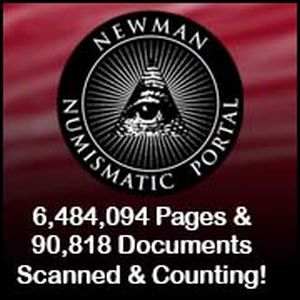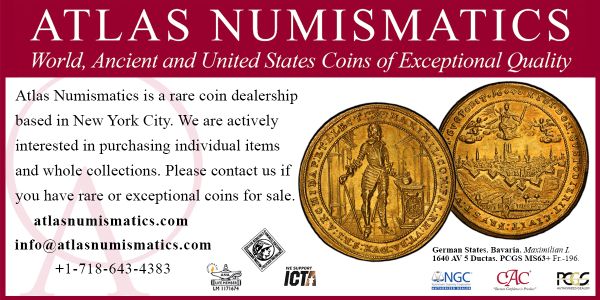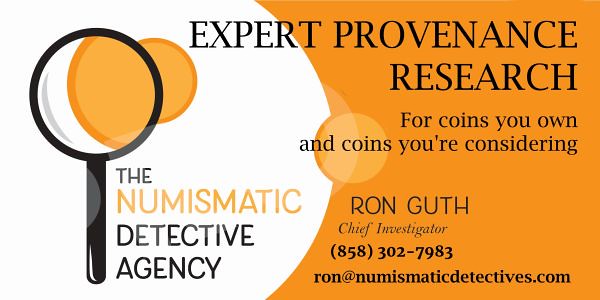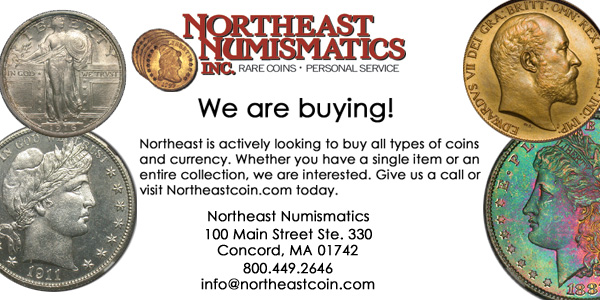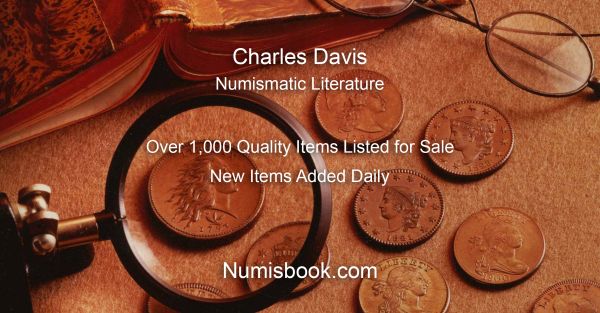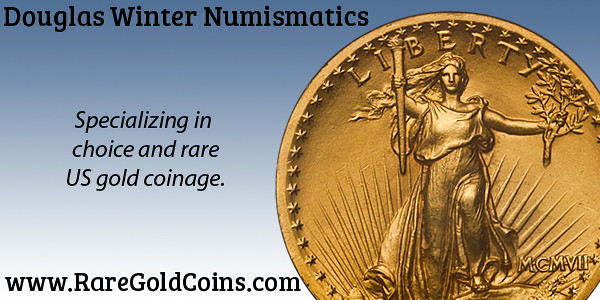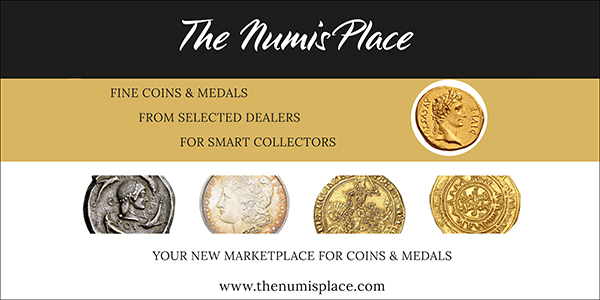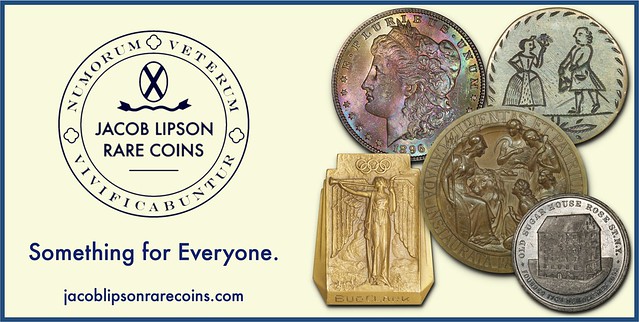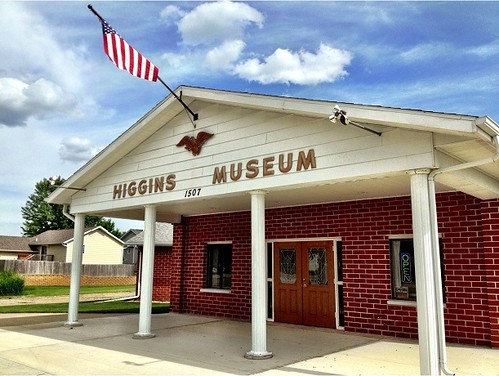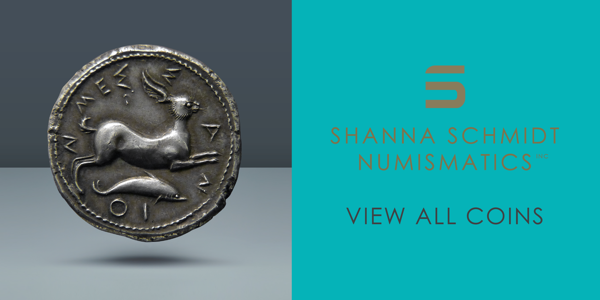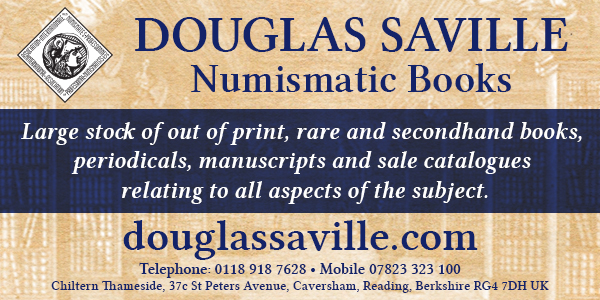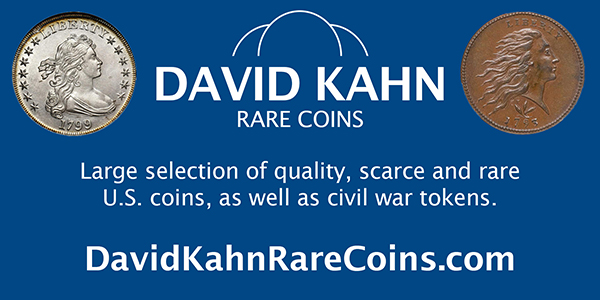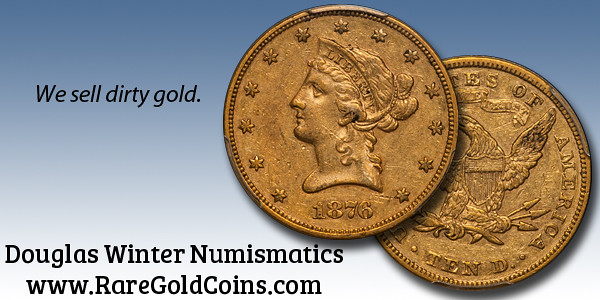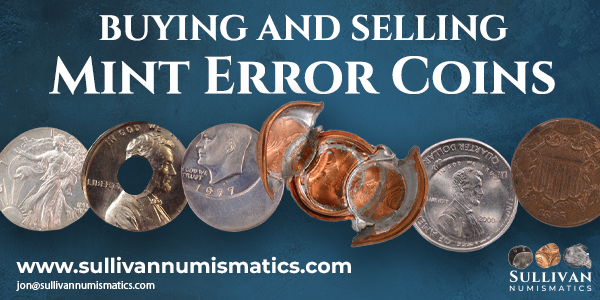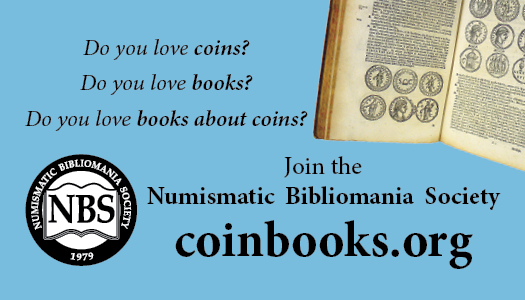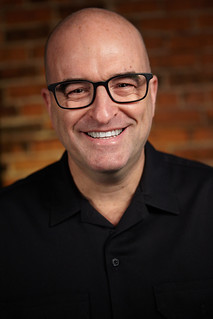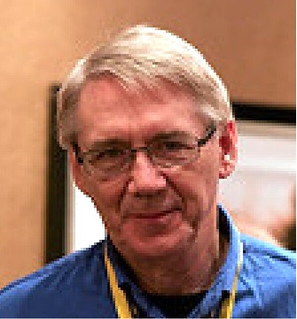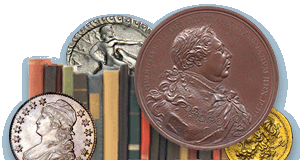
Visit our NBS Sponsors
About UsThe Numismatic Bibliomania Society is a non-profit association devoted to the study and enjoyment of numismatic literature. For more information please see our web site at coinbooks.org SubscriptionsThose wishing to become new E-Sylum subscribers can go to the following web page Subscribe MembershipThere is a membership application available on the web site Membership Application To join, print the application and return it with your check to the address printed on the application. Print/Digital membership is $40 to addresses in the U.S., and $60 elsewhere. A digital-only membership is available for $25. For those without web access, write to: Jeff Dickerson, Treasurer AsylumFor Asylum mailing address changes and other membership questions, contact Jeff at this email address: treasurer@coinbooks.org SubmissionsTo submit items for publication in The E-Sylum, write to the Editor at this address: whomren@gmail.com BUY THE BOOK BEFORE THE COINSale CalendarWatch here for updates! |
- WAYNE'S WORDS: THE E-SYLUM SEPTEMBER 7, 2025
- 2025 ANA NUMISMATIC LITERATURE EXHIBIT AWARDS
- NEW BOOK: THE NUMISMATIST'S GUIDE
- NEW BOOK: TRAVELS WITH THE NAXOS MASTERPIECE
- NEW TITLES IN WHITMAN'S RED BOOK SERIES
- NEW BOOK: CATALOG OF BELGIAN NUMISMATICS 2026
- CHARLES L. (CHUCK) MITTON (1943-2025)
- 2025 ANA CONVENTION NBS EVENTS
- MANUSCRIPTS IN NUMISMATIC LITERATURE & RESEARCH
- VIDEO: HISTORY OF THE RED BOOK
- SUBSCRIBE TO COIN WORLD AND THEIR BRETHREN
- MORE ON THE 16TH 1804 DOLLAR PROVENANCE
- NOTES FROM E-SYLUM READERS: SEPTEMBER 7, 2025
- HIGGINS MUSEUM RECEIVED MAJOR DONATION
- VOCABULARY TERM: ROCKER DIES
- RICHARD DAVID KENNEY (1918-1957)
- NUMISMAGRAM MEDAL SELECTIONS: SEPTEMBER 7, 2025
- WHITWELL HOARD OF BRITISH IRON AGE GOLD COINS
- VICTOR-EMMANUEL III MEDALS OFFERED
- SOVEREIGN RARITIES AUCTION XIX
- KUENKER AUCTION SALE 428
- GADOURY OCTOBER 4, 2025 ROMAN AUREI SALE
- 1715 FLEET: PHILLIP II ROYAL DOCUMENT SEAL
- THE LEWES POUND SHUTS DOWN
- MORE ON THE NEW SRI LANKA 2000 RUPEES NOTE
- ABOUT THIS ISSUE: SEPTEMBER 7, 2025
Content presented in The E-Sylum is not necessarily researched or independently fact-checked, and views expressed do not necessarily represent those of the Numismatic Bibliomania Society.
WAYNE'S WORDS: THE E-SYLUM SEPTEMBER 7, 2025
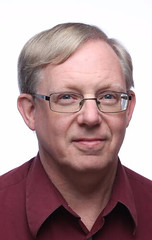 New subscribers this week include:
Hal "Spike" Greinman, courtesy Bill Rosenblum; and
Michael Powers, courtesy Peter Jones;
Welcome aboard! We now have 7,003 subscribers.
New subscribers this week include:
Hal "Spike" Greinman, courtesy Bill Rosenblum; and
Michael Powers, courtesy Peter Jones;
Welcome aboard! We now have 7,003 subscribers.
Thank you for reading The E-Sylum. If you enjoy it, please send me the email addresses of friends you think may enjoy it as well and I'll send them a subscription. Contact me at whomren@gmail.com anytime regarding your subscription, or questions, comments or suggestions about our content.
This week we open with numismatic literature exhibits, six new books, an obituary, updates from the Newman Numismatic Portal, and more.
Other topics this week include the Naxos Masterpiece, Belgian numismatics, the Red Book, the Higgins Museum, rocker dies, author Richard D. Kenney, fixed price and auction selections, iron age gold, Victor-Emmanuel III's medal collection, and the Lewes Pound.
To learn more about Fractional Currency, Private & Pioneer Gold Coins of the U.S., Traditional Money of Africa, the 10 millionth Red Book, the Half Union patterns, Scottish banknotes, the Christopher Columbus "Civilization" medal, the 1887 Gold Pattern Halfpenny for Adolph Weyl, and numisnautics, read on. Have a great week, everyone!
Wayne Homren
Editor, The E-Sylum
2025 ANA NUMISMATIC LITERATURE EXHIBIT AWARDS
Numismatic Bibliomania Society President Len Augsburger submitted this note about the numismatic literature exhibits at the recent ANA World's Fair of Money in Oklahoma City. Thanks. Congratulations to all the winners. -Editor
Numismatic Literature Exhibits at the ANA Convention
The ANA convention exhibits in Oklahoma City included three entries in the Numismatic Literature category. A fourth entry, "Who Is Charles Steigerwalt?" was unfortunately not mounted due to flight cancellations. The three remaining entries were all granted awards, with top honors going to Jeff Dickerson's "Auction Catalogues Featuring the 1804 Dollar." This display included all auction catalogs from 1867 to 2021 that included an original (class I) 1804 dollar.
Second place went to "Fractional Currency Literature," exhibited by Benny Bolin. This display presented reference books, dealer price lists, articles, and auction catalogs related to fractional currency. The third place award went to the exhibit "The 1804 Large Cent – Rarity, Research, and Writings on a Fascinating Coin," which presented archival materials from R. W. Julian and Walter Breen related to the 1804 cent, in addition to a pair of 1804 cents, one original and one restrike. The identity of this exhibitor has eluded us but will be published by the ANA in due course. Thanks to all of these exhibitors for publicizing the collectability of numismatic literature.
Link to ANA 2025 Exhibits, courtesy of Paul Hybert:
http://www.chicagocoinclub.org/events/2025/ana/ex/all_by_cl.html
Paul Hybert adds:
"Looking ahead to 2026, ANA will offer a Collector Exhibit Area at two shows: at Savannah, Georgia in late February, and at Pittsburgh, Pennsylvania in late August. The Rules and Application forms for Savannah are available now, and the Rules and Application for Pittsburgh should be available by October. (And in mid-August at Chicago/Rosemont in 2027, if you need more time to build your exhibit.) See: https://www.money.org/convention-exhibits/
"Applications for Savannah Collector Exhibits should be received by January 16 -- little more than four months away!"
NEW BOOK: THE NUMISMATIST'S GUIDE
Patrick O'Connor has published a textbook of numismatic knowledge, something that has been sorely needed, at least here in the U.S., where there is little academic training and few degrees in the study of numismatics. Here's the announcement. -Editor
The Numismatist's Guide is a textbook that provides a foundation of numismatic knowledge, including many aspects not addressed in other books.
The Numismatist's Guide:
-
 Clarifies basic information and pulls back the curtain on advanced concepts known only to insiders.
Clarifies basic information and pulls back the curtain on advanced concepts known only to insiders.
- Makes numismatics more approachable, enabling you to leap from core concepts to advanced exploration and appreciation of all that numismatics offers.
- Is an essential tool for the seasoned numismatist: an easy to use reference on the foundations of numismatics and a guide to other resources for further study.
- Provides a foundation of understanding for someone new to the field: a text book to empower you to more effectively explore each of the many facets of numismatics.
- Serves as a foundation the numismatic community can discuss and build upon.
Whether you are a seasoned expert or new to the collecting and study of coins, tokens, medals, bullion, or paper money, this book will expand your knowledge and act as a quick reference for continued learning and enjoyment of numismatics!
The Numismatist's Guide is available for purchase beginning August 2025:
The target price is $42.00 for the ebook. The 1st Edition Hardbound book is of extremely high quality and thus costs (much) more than the list price to produce. A limited run of 1st Edition Hardbound books will be offered while supplies last at a commensurately higher price.
Printed Book: 1st Edition Hardbound 420 pages with tables, charts, and full color images.
Limited to 42 books. Available from Aurora Rarities LLC ebay store while supplies last.
If feedback from the community confirms that sufficient demand exists for a printed version, we will investigate production of a lower cost future edition.
Digital eBook: 2nd printing. With clickable links to section headings and external resources.
Available on Apple Books (late 2025)
I have a copy, and it's a substantial work, introducing both basic and advanced concepts and as stated in the Preface, addressing the question "What comprises numismatics as a field of endeavor?" Starting with a brief history of coinage, the book then discusses the nature of money itself and art and culture including how numismatics reflects artistic movements of the day such as Art Nouveau, Art Deco, and even Surrealism (as in the medals of Salvador Dali). More technical topics include Metrology, Metallurgy and Assaying, and the history and methods of the minting process. Similarly, the book covers the making of paper and printing techniques for paper money, including security features. And that's just Chapter One. Other chapters address numismatic fundamentals (including authentication, conservation and preservation, as well as research), the numismatic community, grading, the marketplace, regulation, and numismatic organizations. Appendices cover numismatic literature (a handy bibliography) and sources used in writing the book itself.
It looks like a very handy book for all numismatists, and I'm intrigued with the thought of it as a textbook for introducing the wide field of numismatics not only to aspiring collectors and dealers, but to academics in adjacent fields such as art, economics and archaeology, where a deep understanding of numismatics is scant but sorely needed. -Editor
For more information, or to order, see:
The Numismatist's Guide
(https://www.thenumismatistsguide.com/the-book.html)
NEW BOOK: TRAVELS WITH THE NAXOS MASTERPIECE
Through the September 2025 American Numismatic Society email I learned about a book published by Spink that I don't believe we've mentioned before. A copy was recently acquired by the ANS Library. -Editor
 Travels with the Naxos Masterpiece:
Travels with the Naxos Masterpiece:
An introduction to Greek Numismatics through the lives of a Sicilian Coin
by Tim Wright
210 x 148mm Portrait
Hardback, PPC
Colour illustrations throughout
224 pages
ISBN: 978-1-911718-08-6
£30.00
The Naxos coin is a strong contender to be a numismatic masterpiece. Attributed to the Aetna Master, it is admired for its innovative composition and stunning execution, which marked the transition between archaic and classical styles. It is thought to have been issued in c. 460 BCE to celebrate the Naxians return from exile, just over half a century before the destruction of what had been the first Greek settlement in Sicily. Struck from a single die-pair, desirability and rarity combine to achieve some of the highest hammers when one comes to auction.
The Naxos coin only started to be documented from the eighteenth century, and it was only in the mid-nineteenth century that large numbers were found near the site of the city. From there, this most prized of ancient coins travelled across Europe and then America to become part of the world's great public and private collections. Inevitably, its status and value made it vulnerable to those tempted to break the laws designed to protect cultural heritage.
Travels with the Naxos Masterpiece explores the ‘lives' of these magnificent coins, from their ancient origins in Greek Sicily, through discovery and collection, to sale in the modern market. They continue to be defined by the impact that they have on all who have the privilege to encounter them.
For more information, or to order, see:
Travels with the Naxos Masterpiece: An introduction to Greek Numismatics through the lives of a Sicilian Coin by Tim Wright
(https://spinkbooks.com/products/travels-with-the-naxos-masterpiece-an-introduction-to-greek-numismatics-through-the-lives-of-a-sicilian-coin-by-tim-wright)
NEW TITLES IN WHITMAN'S RED BOOK SERIES
This fall, Whitman will release three new titles in its Red Book Series™: United States Type Coins, 4th Edition in early September, Private & Pioneer Gold Coins of the United States in mid-September, and Flying Eagle & Indian Head Cents, 4th Edition in October. -Garrett
Spotlight: United States Type Coins, 4th Edition
Collecting all U.S. coins by date and mintmark is popular but can be difficult. The award-winning United States Type Coins introduces collectors to one of the most rewarding pursuits in numismatics: building a collection by coin type. This newly updated edition explores more than 250 distinct coin designs, from the nation's earliest half dimes of 1792 through today's American Innovation dollars. With mintages, grading guides, values in up to nine grades, hundreds of color photos, and GSID catalog numbers, the book is a complete reference for type-coin enthusiasts.
"Type-coin collecting is one of the most rewarding and accessible ways to explore American numismatics," said Jeff Garrett, Senior Editor of the Red Book. "Each coin tells a story—from early copper to modern clad issues—and together they form a panoramic view of our nation's coinage history."
Fan Favorite Returns: Flying Eagle & Indian Head Cents, 4th Edition
Beloved by collectors for their artistry and history, Flying Eagle and Indian Head cents take center stage in this expanded edition by Richard Snow. Covering America's first small cents, struck from 1857 to 1858, and the iconic Indian Head series minted from 1859 to 1909, this reference offers detailed mintages, grading, die varieties, errors, exonumia, counterfeit detection, and values in up to nine grades (including Brown, Red-Brown, and Red). More than 400 full-color images bring these coins to life.
New Release: Private & Pioneer Gold Coins of the United States
For the first time, Whitman's Red Book Series explores private and territorial gold coinage with Private & Pioneer Gold Coins of the United States. Written by Donald H. Kagin, Ph.D., and David J. McCarthy, this volume chronicles gold coins minted outside federal authority between 1786 and 1862. From Brasher doubloons to fractional gold pieces and massive $50 slugs, these coins reflect the ingenuity of America's gold-rush era and are presented with history, pricing in up to nine grades, Kagin and GSID numbers, and hundreds of photographs.
Leadership Perspectives
John Feigenbaum, CEO of Whitman Brands™, emphasized the importance of these releases in propelling the numismatic community forward—maintaining momentum and delivering fresh resources that fuel the hobby:
"We are incredibly proud of our team and our authors for pushing the Red Book Series forward with fresh updates and new coverage where needed. These upcoming titles, along with Red Book Quarterly (formerly CPG Coin & Currency Market Review), the Red Book Podcast with Jeff Garrett, Mega Red X, Red Book 2027, and other initiatives reflect our commitment to delivering trusted, innovative, and collector-focused resources."
Patrick Ian Perez, Chief Publishing Officer, noted:
"Working with authors like Jeff Garrett, Don Kagin, David McCarthy, and Richard Snow makes our job easy and rewarding. Our goal is to bring their passion and expertise to life, while standardizing the way we present content across the Red Book Series and balancing historical narrative with coin-by-coin analysis, market values, industry-standard reference numbers, and industry insight."
Michael Pfeifer, Chief Operating Officer, added:
"Refreshing the Red Book Series—inside and out—has been a fun and collaborative process. From new covers to expanded market data to new titles, we're ensuring collectors have access to what they want most: up-to-date prices for popular series like silver dollars, timely revisions for ongoing series like quarters, expanded coverage for niche areas like private and territorial gold, and digital editions available in more retail outlets and accessible formats."
About the Red Book Series
Whitman's Red Book Series™ comprises nearly 30 volumes, each dedicated to in-depth coverage of specific U.S. coin types and programs. Collectors enjoy stunning photographs, historical insights, grade-by-grade price charts, mintages, market analysis, collecting tips, and more. From Civil War Tokens and Continental Currency to Lincoln Cents and American Silver Eagles, the series has something for collector, investors, and history buffs alike. For the comprehensive listing of all series titles, visit Whitman. All updated and new volumes feature market values in the maximum number of grades based on the industry-standard Red Book Quarterly retail pricing, as well as Greysheet Identification (GSID) catalog numbers that easily identify and link a coin across the entire family of Whitman products.
Looking Ahead
Whitman confirmed forthcoming updates to cornerstone Red Book Series titles, including Morgan Silver Dollars (Vol. #1), Double Eagle Gold Coins (Vol. #2), Modern U.S. Proof Coin Sets, (Vol. #4), Lincoln Cents (Vol. #9), and United States Paper Money in 2026. Exciting new additions are also planned, such as Walking Liberty Half Dollars (a standalone volume) and Half Eagle Gold Coins (Vol. #29).
Published by Whitman®, the most trusted name in numismatic literature, all titles are available for order at Whitman, and will be available for purchase at Amazon, Ebay, Walmart.com, and bookstores, hobby shops, and other authorized retailers nationwide in the coming weeks.
For media inquiries, review copies, or interviews with the authors, contact Mike Pfeiffer at 757-955-0393, mike@whitmanbrands.com, or press@whitmanbrands.com.
Meet the Authors
Q. David Bowers is the most prolific and celebrated numismatic author in U.S. history. Over the course of his career, he has written more than 60 reference works, including many volumes in Whitman's Red Book Series, covering virtually every area of American coinage. A past president of both the American Numismatic Association and the Professional Numismatists Guild, Bowers has received nearly every major honor in the hobby for his scholarship, integrity, and dedication. His books, lectures, and mentorship continue to shape generations of collectors and researchers, making him one of the most influential figures in numismatics worldwide.
Rick Snow is a leading authority on Flying Eagle and Indian Head cents, with more than four decades of experience as a dealer, author, and educator. He founded Eagle Eye Rare Coins and the Fly-In Club, both of which remain cornerstones for collectors of small cents. Snow authored The Flying Eagle and Indian Cent Attribution Guide, now in its third edition, and pioneered the Eagle Eye Photo Seal program to uphold strict grading standards. His innovative PDS grading system further demonstrates his commitment to improving accuracy and transparency in numismatics, making him one of the most trusted names in the hobby.
Donald H. Kagin, Ph.D. is one of the most respected authorities in American numismatics and the first person in the United States to earn a doctorate in the field. His expertise centers on Pioneer gold coins, U.S. currency, and numismatic investments. Author of the award-winning Private Gold Coins and Patterns of the United States and a frequent contributor to leading publications, Dr. Kagin has advised governments, banks, and private collectors, while also serving as president of Kagin's, Inc., the nation's oldest family-owned numismatic firm. A sought-after speaker and educator, he has been a leader in advancing numismatic scholarship and collector education nationwide.
David McCarthy is Senior Numismatist and Researcher at Kagin's, recognized for his expertise in Pioneer gold and regulated gold coinage. Since entering the field in 2000, he has handled many of the greatest U.S. and world rarities and has consulted for banks, museums, grading services, and the Smithsonian Institution. A regular contributor to the Red Book and Coin World, McCarthy has also taught advanced courses for the American Numismatic Association and is widely sought as a lecturer and commentator. Known for his passion and keen eye for detail, he is regarded as one of today's leading numismatic professionals.
NEW BOOK: CATALOG OF BELGIAN NUMISMATICS 2026
Laurens Aernout has published a new edition of his catalog of Belgian numismatics. -Editor
 NEW Catalog of Belgian Numismatic Issues 1831-2026!!!
NEW Catalog of Belgian Numismatic Issues 1831-2026!!!
Available on November 1, 2025!!!
This edition is only about the Kingdom of Belgium - Only available in Dutch - No lexicon !!
Contents: the coins, banknotes and sets of the Belgian franc as well as the euro. Also the Belgian ECU coins, medals and sets, together with the commemorative medals. No colonial territories!
The most complete catalogue on Belgian Numismatics in words and pictures! Main language: Dutch. Be quick to get your copy of this iconic series. A catalogue made for and by collectors, a unique project !!!
Features: CBNU2026: 560 pages, black/white, 17cm high x 12cm wide x 3cm thick, 700gr+, ISBN 9789082449044.
Price: CBNU2026 is only 24EUR, postage not included !!
NOTE: The book cannot be shipped to the USA; as of October 29, 2025, all shipments outside Europe have been stopped.
You can order this catalog by depositing the amount of €24 + €8 postage in Belgium (Postage abroad by appointment) into the account (IBAN: BE42 4650 1171 0154 BIC: KREDBEBB) of Numismatica Zuidwest-Vlaanderen, with the reference CBNU2026, your name and address.
Chapters:
1) Belgian Franc - Coins
- All coins, 1 cent up to and including 5000 Francs, from the Belgian Franc period 1831-2001
2) Belgian Franc - Sets
- All FDC sets with their tokens from the Belgian Franc period 1970-2001
3) Belgian Franc - Proof Sets
- All PROOF sets from the Belgian Franc period 1990-2001
4) Belgian Euro - Coins
- All coins, 1 cent up to and including 1000 Francs, from the Belgian Euro period 1999-2016
- Photos and an article about the 2 euro 2015 - Waterloo!
5) Belgian Euro - Kits
- Kits for self-employed and private persons
6) Belgian Euro - Sets
- All FDC sets with their tokens from the period of the Belgian Euro 1999 - 2016
7) Belgian Euro - Proof sets
- All PROOF sets from the period of the Belgian Euro 1999 - 2016
8) Belgian Euro - Sets - Benelux
- All FDC sets with their tokens from the period of the Euro 2003 - 2016
9) Belgian ECU - Coins
- All coins, 5 ecu up to 100 ecu, from the period of the Belgian ECU 1987 - 1998
10) Belgian ECU - Medals
- All medals from the period of the Belgian ECU 1991 - 1994
11) Belgian ECU - Sets
- All FDC sets from the period of the Belgian ECU 1991 - 1994
12) Belgian ECU - Proof sets
- All PROOF sets from the period of the Belgian ECU 1987 - 1998
13) Belgian Commemorative Medals
14) Belgian Francs - Banknotes
15) Belgian Euro - Banknotes
Tools:
- Handy overview of the silver and gold content of the issued Belgian coins (Franc and Euro)
- Practical tool to recognize the differences of the gold 20 franc pieces under Leopold II
- Informative article about the difference between overstrikes and Incuse traces on the cents of Leopold I
- The reuse of the copper cents under Leopold I
- How to use the cardinal directions to describe overstrikes
- 100 Francs Lombard - series 3000
- Recognizing masterful forgeries: Flemish 100 Francs 1950
For more information, see:
https://www.cbnu.be/home/
CHARLES L. (CHUCK) MITTON (1943-2025)
Bill Rosenblum of Littleton, CO passed along an obituary and remembrances of his friend Chuck Mitton. Thank you - sorry to hear this news. -Editor
 Charles Lee Mitton, affectionately known as Chuck, passed away peacefully with his family by his side on August 31, 2025, in Littleton, Colorado, at 81.
Charles Lee Mitton, affectionately known as Chuck, passed away peacefully with his family by his side on August 31, 2025, in Littleton, Colorado, at 81.
Born and raised in Denver, Colorado, Chuck was a proud second-generation native. He was the son of the late Charles Earl Mitton and Iris Helen Martin. Chuck graduated from the University of Denver with a Bachelor's Degree in Business Administration. While in school, he worked for the University Hills Bank, where he learned hands-on training that proved more valuable than his formal education.
Chuck built an accomplished career in finance and insurance. Beyond his professional life, he pursued his passions with enthusiasm and dedication. An avid traveler, he journeyed extensively throughout the US and the world, including many memorable trips to Africa with his father, and later his family. These experiences fostered a lifelong fascination with culture, history, and numismatics. Chuck became an expert in primitive money and was a devoted and active member of the American Numismatic Association, where he frequently presented and shared his knowledge with others. To know Chuck was to know his memorable handlebar mustache and to have seen and appreciated his personal African Museum in his basement.
Chuck also cherished the outdoors and spent much of his free time with his beloved wife and family in the Rocky Mountains of Colorado. Whether biking or exploring the trails in his 1950s Willys Jeep, his love for the mountains and his family was ever-present. He will be remembered for his devotion to his loved ones—including his dogs and grand dogs—and for the warmth, humor, and generosity he brought to those around him.
Bill adds these remembrances. Thank you. -Editor
 Chuck was the author of the self-published book Ethnic Groups and Traditional Money of Africa: Cross Reference Guide. (2005).The 173 page large size, spiral bound book was divided into 5 chapters including African Ethnic Groups; Sorted by Ethnic group, African Ethnic Groups; Sorted by Country; Artifacts and Traditional Money; Sorted by name, Artifacts and Traditional Money; Sorted by Description and Artifacts and Traditional Money; Sorted by Country. It's an invaluable resource for those who collect, buy, sell or catalog African Odd & Curious Money.
Chuck was the author of the self-published book Ethnic Groups and Traditional Money of Africa: Cross Reference Guide. (2005).The 173 page large size, spiral bound book was divided into 5 chapters including African Ethnic Groups; Sorted by Ethnic group, African Ethnic Groups; Sorted by Country; Artifacts and Traditional Money; Sorted by name, Artifacts and Traditional Money; Sorted by Description and Artifacts and Traditional Money; Sorted by Country. It's an invaluable resource for those who collect, buy, sell or catalog African Odd & Curious Money.
In addition to the ANA (LM-4855) Chuck was a member of (and contributor to) the International Bank Note Society (IBNS), the IPMS (International Primitive Money Society), the Bill Henderson Supper Club, DAWN (Denver Area World Numismatists) and a founding member of PANDA, (Poker and Numismatics in the Denver Area), the Bill Henderson Supper Club. For many years Chuck volunteered weekly or almost weekly to the ANA Museum
For many years Chuck volunteered weekly or almost weekly to the ANA Museum. In the late 1970s Chuck, along with Bob Gardner, Hal "Spike" Greimann, Dave Koble and Bill Rosenblum formed a partnership (Mile High Shows) to organize large coin shows in Denver when the CWNA stopped running shows. Eventually the coin show operation was sold to Jerry Morgan who ran it for many years. After he retired the show was run by Jabon (last name escapes me) before Neal Hatgi bought the show in 2018. In addition to his collection of African Odd & Curious Money and other African art and objects Chuck collected all of African numismatics including ancient coins, dark ages coinage, modern coins and African paper money. Africa to Chuck meant many (but not all) of the Islands off the coast of Africa.
During the 1990s and the first decade of the 21st century Chuck, along with Rita and Bill Rosenblum, gave many show and tell presentations to coin clubs up and down the front range of Colorado on Odd and Curious. No squinting at tiny coins from across the room, Katanga Crosses and Spear Money could be seen by one and all. And if you did not mind getting your hands dirty you could pick up a leg band or a kissi penny.
Chuck helped Bill at coin shows and auctions in Colorado and across the country. He was in charge of the money bag. His years of working at a bank as a young man kept everything organized and easy to find, The banknotes were all facing the same way and all were the right side up. Nowadays when I get cash from a bank they give me banknotes facing different ways and half of them are upside down. Chuck would have been aghast. Chuck and I shared many a hotel room and many (some may say too many) glasses of gin. He was my biking buddy. Almost every weekend, when I wasn't at a show, for 15 plus years we would bike on bike paths, trails and roads in the metro Denver area.
Instead of flowers, please consider donating to the Alzheimer's Association at www.alz.org.
Chuck's Celebration of Life:
Two Fingers Tap & Grill & Event Center
13065 E Briarwood Ave.
Centennial CO 80112
Saturday October 4th: 2 to 6 PM
2025 ANA CONVENTION NBS EVENTS
The latest additions to the Newman Numismatic Portal are videos of Numismatic Bibliomania Society events at the recent ANA World's Fair of Money in Oklahoma City. Project Coordinator Len Augsburger provided the following report. -Editor
Numismatic Bibliomania Society ANA Events on Video
The NBS events from the recent ANA convention are now available on YouTube, courtesy of Lianna Spurrier. The NBS Symposium, held August 21, features Jeff Garrett, Senior Editor of the Red Book, speaking on the Guide Book of U.S. Coins, followed by Len Augsburger, who presents on the 1992 M. N. Daycius caper. The prankster behind this bibliophilic April Fools hoax is publicly revealed here for the first time. Video of the NBS annual meeting, held August 22, includes the NBS literary awards presentation and the charity fundraiser, which raised a total of $7,815 for the club treasury. Many thanks to the donors and bidders for their generous support of the NBS.
Link to NBS Charity Auction on YouTube:
https://youtu.be/33tUmv9uY1c
Link to NBS Symposium on YouTube:
https://youtu.be/JspyXpxmIjs
Link to NBS Charity Fundraiser catalog, including prices realized:
https://nnp.wustl.edu/library/auctioncompanydetail/512295
MANUSCRIPTS IN NUMISMATIC LITERATURE & RESEARCH
NBS President and Newman Numismatic Portal Project Coordinator Len Augsburger is speaking at the Manuscript Society on Monday, September 8, 2025. -Editor
The Role of Manuscripts in Numismatic Literature & Research
Overview
This presentation will provide an overview of the numismatic literature field and highlight significant manuscript items in American collections. We will explore the most significant repositories of numismatic manuscript materials and share first-hand observations of working with related institutions. The talk will cover specific applications of manuscripts within numismatic research, drawing on the presenter's and other publications.
Date: Monday, September 8, 8PM EST
Guest Presenter: Len Augsburger
Host: Gerald "Jay" Gaidmore
Presenter
 Len Augsburger is the Project Coordinator of the Newman Numismatic Portal (NewmanPortal.org) project at Washington University in St. Louis. He has published widely in the field of American numismatics and has three times won the Numismatic Literary Guild's "Book of the Year" award. His most recent publication, The Publication of Eric P. Newman: A Collector's Guide, summarizes a decade of curation of the Eric P. Newman numismatic papers. Len is a Fellow of the American Numismatic Society and holds leadership positions in other numismatic organizations.
Len Augsburger is the Project Coordinator of the Newman Numismatic Portal (NewmanPortal.org) project at Washington University in St. Louis. He has published widely in the field of American numismatics and has three times won the Numismatic Literary Guild's "Book of the Year" award. His most recent publication, The Publication of Eric P. Newman: A Collector's Guide, summarizes a decade of curation of the Eric P. Newman numismatic papers. Len is a Fellow of the American Numismatic Society and holds leadership positions in other numismatic organizations.
For more information, or to register, see:
Manuscript Mondays: The Role of Manuscripts in Numismatic Literature & Research
(https://manuscript.org/event/manuscript-mondays-the-role-of-manuscripts-in-numismatic-literature-research/)
VIDEO: HISTORY OF THE RED BOOK
The David Lisot Video Library on the Newman Numismatic Portal can be found at:
https://nnp.wustl.edu/library/multimediadetail/522852
We highlight one of his videos each week in The E-Sylum. Here's one from 2009 with Dennis Tucker and Ken Bressett reviewing the history of the Redbook. -Editor
No other coin guide book has influenced as many collectors the Guide Book of United States Coins, known nationwide as the "Red Book." Now, hobby legend and longtime Red Book editor Kenneth Bressett recounts the marvelous history of this #1 best-seller. Whitman publisher, Dennis Tucker, accompanies him and shares his recollections as well as current Red Book news.
Speakers: Kenneth Bressett & Dennis Tucker.
To watch the complete video, see:
History of the Red Book
(https://youtu.be/wG6lkGa631g)
History of the Red Book
(https://nnp.wustl.edu/library/book/560424)
THE BOOK BAZARRE
SUBSCRIBE TO COIN WORLD AND THEIR BRETHREN
Vic Mason writes:
"There's so much interesting and exciting (as usual) in the new E-Sylum: (1) the 1804 dollars and the rampant corruption at the United States Mint in the 1870s; (2) the missing 1709 Stradivarius violin; (3) the report from the Oklahoma City convention; (4) the coin hunt going on in the Chicago park (enjoyed the typo: "handmade dyes"!); (5) King Charles on Falklands Islands currency (Argentina must love that); (6) the Q. David Bowers video; and so much more. You're looking good for 27!
"I especially want to comment on (7) the ongoing saga at Coin World. After returning to coin collecting in a serious way in 2002, I have found Coin World the single most important educational tool in (a) understanding the revolutionary changes in American numismatics since ethical third-party grading was introduced at NGC and PCGS in the 1980s; (b) regularly staying abreast of important numismatic developments; and (c) learning so much about the history of American and international numismatics. The publication has helped me greatly in giving advice to that small army of "amateur" collectors out there who have inherited coins, but, not being members of coin clubs or of the American Numismatic Association, know nothing about how to value their possessions for estate-planning purposes."
Ted Puls had a changing experience as his interests developed from U.S. to world coinage. -Editor
Ted writes:
"I have been a subscriber to Coin World since about the 1970's. The weekly reading was initially very educational then, during "higher education", it became a weekly respite from stress. As time went on my interest in world coins increased and Coin World's interest seemed to decrease. It became a sales sheet about prices of U.S. coins that sold and often included little history or story except how much it sold for before. I was going to stop resubscribing last year due to this but instead wrote a letter and asked for more world coin articles. My self centered evaluation was that they did improve the world coin article (yes singular word is intended) but did not increase in telling history, or even the "story", about the coin in the rest of the paper. This direction which excludes beginning collectors interest and mine, worries me for the future of the hobby."
Last week I noted how we all need to support our numismatic publications with our subscription and advertising dollars. As a public service, here are links to subscribe to the major U.S. commercial numismatic publications. -Editor
COIN WORLD: Digital access to the monthly Coin World magazine starts at just $24.99/year
NUMISMATIC NEWS and NUMISMASTER : For years I was confused by Numismatic News's offerings. It seemed like a binary choice between the print publication or the complete Numismaster bundle which included pricing data that I don't use or want. But Jeff Starck helped me see that individual subscriptions to their three publications are indeed available.
One year of the digital Numismatic News (36 issues) is just $20, and there are options for print only or a print/digital bundle for $35/year. One year of the digital World Coin News and Bank Note Reporters publications are $20 and $22 respectively - all bargains.
 COINAGE MAGAZINE : Likewise, the bimonthly COINage Magazine offers print, digital and bundled subscriptions as well as single issue purchases. One year (6 issues) of the digital subscription is $14.95.
COINAGE MAGAZINE : Likewise, the bimonthly COINage Magazine offers print, digital and bundled subscriptions as well as single issue purchases. One year (6 issues) of the digital subscription is $14.95.
There, was that so hard? Enjoy your new subscriptions and let us know what you think of some of the articles you read. -Editor
To read the earlier E-Sylum article, see:
COIN WORLD – A TALE OF TWO ISSUES
(https://www.coinbooks.org/v28/esylum_v28n35a12.html)
MORE ON THE 16TH 1804 DOLLAR PROVENANCE
Steve Hill of Sovereign Rarities writes:
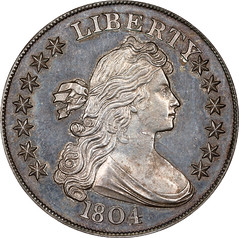 "Last week's edition was a very interesting one with multiple articles of interest and perhaps the most intriguing being the trail (or lack of) for the provenance of the 1804 Dollar in the James Stack collection that we all saw in Oklahoma City."
"Last week's edition was a very interesting one with multiple articles of interest and perhaps the most intriguing being the trail (or lack of) for the provenance of the 1804 Dollar in the James Stack collection that we all saw in Oklahoma City."
Len Augsburger writes:
"The piece was a bit speculative, but stirring the pot can be a good thing. Edgar Adams is as good a guess as any."
Bill Eckberg writes:
"Wholesale returns of conjecture out of such a trifling investment of fact. (Apologies to Mark Twain)"
The article's author Doug Ward writes:
"We'll see what appears, but unless Mr. Stack had a journal or ledger it's likely to be nothing but speculation... In such an event, there are very few other 'logical' choices. Unfortunately, numismatic history is littered with those more concerned in the end with their vanity, than with documenting their transgressions. Circumstantial evidence is all that remains. "
Yes, the idea is speculative, and hedged with words and phrases like "I would postulate" and "probably". As noted earlier, the auction catalog description for the James A. Stack 1804 Dollar has yet to be written and published, so stay tuned on the provenance of this piece. Clues that may have been overlooked before will be reviewed in the new light of this discovery and the inevitable speculation it spawns. As Len noted, Edgar Adams is a logical choice. But not the only one. The Fantastic 1804 Dollar has been the stuff of fantasy since its murky beginnings, so the latest discussions are only par for the course. And we'll look forward to more.
Here's a taste - Craig Sholley and John Dannreuther submitted the following. -Editor
We read Douglas Ward's article discussing the provenance of the 16 th known 1804 dollar and the Woodin fifty dollar ("half union") pattern debacle in the Aug. 31, 2025 issue of The E-Sylum and wish to point out several inaccuracies.
First, the historical record shows that it was Henry Linderman, not A. Loudon Snowden, who was behind the majority of the restriking prior to his death in 1879. Both mint records and historical auction records show that large-scale restriking for profit began at the mint in the mid-1850s and continued unabated through early 1864.
During that time Linderman was the "Director's Clerk." While that may sound like a minor clerical position, it was anything but. The mint's "Rules and Regulations," first written in 1795, reveal that the Director's Clerk was responsible for overseeing the day-to-day operations of the mint, including work assignments and ensuring the work was proceeding on schedule. He was literally the plant manager. He had all of the keys to the vaults and the combinations to the safes.
At this same time, A. Loudon Snowden was the "Registrar of Deposits," responsible for logging-in and recording all of the information about bullion deposits at the mint. He had nothing to do with coining or any other manufacturing operation. Linderman chose him as a partner-in-crime mainly because he was Mint Director James Ross Snowden's nephew. So, if Linderman was fired for his activities, the Director's nephew would also go, embarrassing James Ross and the entire family. Imagine explaining that one at the next family get-together.
We presented much of this information in several articles including "Gobrecht Dollar
Restrike and Cabinet Coins" in the June 2016 issue of The Numismatist and "The
Supposed Destruction of the Proof Half Cent Restrike Dies" in the January 2023 issue
of Pennywise. A summary is also available on the "DTS Die Stating Guide" website at
gobrechtdollars.com/emissionSeq.html.
As to the infamous half union pattern debacle, letters between Woodin and his lawyers discussing the matter came to light in 2004. The letters reveal that A. Loudon Snowden had sold the half union patterns to Woodin. When the government threatened legal action to recover them, Woodin returned the disputed pieces to A. Loudon, who summarily returned them to the mint, and repaid Woodin by giving him two trunks of patterns he had taken from the mint on his departure.
Dannreuther discussed these letters in his article, "William Woodin's Purchase of Two
Gold Half Unions" in the March 2013 issue of The Numismatist. Subsequently, Saul
Teichmann published the main letter detailing the origin of the patterns and their return
on US Patterns website under the listing for the half unions, Judd-1546, available at:
https://www.uspatterns.com/j1546p1719.html.
As to the 1804 dollars, new information has recently come to light which shows that Henry Linderman was responsible for both the Class II and Class III dollars. We will be presenting that information in an upcoming article.
To read the earlier E-Sylum articles, see:
NOTES FROM E-SYLUM READERS: AUGUST 24, 2025 : Can Coin Counterfeiters Fool the Experts?
(https://www.coinbooks.org/v28/esylum_v28n34a10.html)
ON THE PROVENANCE OF THE 16TH 1804 DOLLAR
(https://www.coinbooks.org/v28/esylum_v28n35a14.html)
NOTES FROM E-SYLUM READERS: SEPTEMBER 7, 2025
More on Scottish Banknotes
David Pickup writes:
 "Small point but I do not think that Scottish Banknotes are legal tender in England. The phase "legal tender" has a specific technical meaning but in the wider sense banks in England do not have to take them.
"Small point but I do not think that Scottish Banknotes are legal tender in England. The phase "legal tender" has a specific technical meaning but in the wider sense banks in England do not have to take them.
"One pound banknotes seemed to be used in Scotland much longer than in England when pound coins were introduced."
Sorry - I've seen many articles in the past about objections to these not being accepted, but had only assumed their legal status. Here's an earlier statement from the Scotsman: -Editor
"Apparently they are legal currency – approved by the UK parliament – but not legal tender. Not even in Scotland. In fact, no banknote whatsoever, even a Bank of England one, qualifies for the term "legal tender" north of the Border. But the Bank of Scotland has been issuing its own notes since it was founded 1695, with the Royal Bank of Scotland following suit in 1727 and then the Clydesdale a century later, in 1838.
"The vast majority of establishments in the rest of the UK are happy to take our cash."
To read the earlier E-Sylum articles, see:
ENGLISH MCDONALD'S REFUSES SCOTTISH BANKNOTES
(https://www.coinbooks.org/esylum_v19n39a40.html)
LOOSE CHANGE: AUGUST 31, 2025 : English Pub Chain Bans Scottish Banknotes
(https://www.coinbooks.org/v28/esylum_v28n35a23.html)
HIGGINS MUSEUM RECEIVED MAJOR DONATION
Great news! The Higgins Museum of National Bank Notes has received a major donation. -Editor
An anonymous Pennsylvania coin collector recently donated around $750,000 to the Higgins Museum of National Bank Notes. This marks one of the largest gifts in the Okoboji museum's 46-year history.
"Seven Lions," the anonymous donor, consigned 110 U.S. pattern coins to California-based auction house Stack's Bowers. The first 29 coins sold for $725,000 on July 27. Another $25,ooo came from the sale of 81 additional coins on Friday, Aug. 29.
Seven Lions plans to donate both auction proceeds, as well as hundreds of additional bank notes, to expand the museum's collection. The gift would add 700 national bank notes to the current 2,600-note display.
"This is where (we) don't know yet," Museum Curator George Cuhaj said. "Do we build a renovation? An extension to house an additional part of his collection?"
HIGGINS HOUSES RARE COLLECTION
 The Higgins Museum opened in 1978 to display founder Bill Higgins' national bank note collection.
The Higgins Museum opened in 1978 to display founder Bill Higgins' national bank note collection.
Higgins himself grew up in the Iowa Great Lakes Region, and served as mayor of Okoboji from 1960-1974. He was well-known for being a coin collector.
During his last year in office, Higgins sold his collection of 6,000 silver world crowns. He used the proceeds to buy paper money. Today, Higgins Museum houses the largest permanent display of national bank notes in America. It features a collection ranging from Iowa to Minnesota, South Dakota, Nebraska and Missouri.
WHAT'S IN STORE?
Higgins Museum operates from 11 a.m. to 5:30 p.m., Memorial Day through Labor Day, so it is currently closed.
Museum officials have reserved a special booth at the April 2026 Great American Coin and Collectible Show in Rosemont, Ill. Back home, the museum will host five speakers for a two-day seminar Aug. 12-13, 2026. The programs will cover the history of national bank notes.
Cuhaj hopes any new additions will be completed by the museum's 50th anniversary in 2028.
"Most of our visitors are excited to learn that a bank from their community issued bank notes," Cuhaj said. "It really is something special … we made this."
Higgins Museum raised additional funds from national paper money clubs to renovate its Missouri exhibit, which has been in place since 2011. The Seven Lions donation also follows a $3,000 grant from the Spirit of Okoboji Foundation.
Curator George Cuhaj adds:
"The article was written only with the first part results; with the second part now done, the expected total is closer to $1.1 million."
To read the complete article, see:
Anonymous collector gives $750,000 donation to Higgins Museum
(https://www.dickinsoncountynews.com/articles/dickinsoncountynews-2/anonymous-collector-gives-750000-donation-to-higgins-museum/)
To read an earlier E-Sylum article, see:
WILLIAM ROBERT HIGGINS, JR.
(https://www.coinbooks.org/v26/esylum_v26n29a16.html)
VOCABULARY TERM: ROCKER DIES
Here's another entry from Dick Johnson's Encyclopedia of Coin and Medal Terminology. -Editor
Rocker Dies. A pair of dies engraved on the curved interface surfaces, one convex and one concave. Unlike roller dies where the designs were engraved on cylinders and continuously rolled on a strip of metal (then blanked or cut out afterwards), an individual blank was impressed between a mated pair of rocker dies which were rocked back and forth under pressure until the design was struck up. This method required a special rocker press. It was intended to replace the screw press but did not.
Both of these coinage methods proved impractical: the rocker dies because of imperfect impressions and misshapen coins they created, and the roller die for the manual trimming necessary for individual coins after cutting out.
To read the complete entry on the Newman Numismatic Portal, see:
Rocker Dies
(https://nnp.wustl.edu/library/dictionarydetail/516668)
RICHARD DAVID KENNEY (1918-1957)
E-Sylum Feature Writer and American Numismatic Biographies author Pete Smith submitted this article on exonumia researcher and writer Richard D. Kenney. Thanks! -Editor
 During the ANA World's Fair of Money in Oklahoma City, I received a suggestion to write an
article about Richard D. Kenney. I appreciate such suggestions. This proved to be a challenge.
His family had a knack for keeping their names out of the papers.
During the ANA World's Fair of Money in Oklahoma City, I received a suggestion to write an
article about Richard D. Kenney. I appreciate such suggestions. This proved to be a challenge.
His family had a knack for keeping their names out of the papers.
I learned quickly that he had two names. Along the way, I came across a serious error in one of my usually reliable sources. Julia Casey helped me around that problem and found some great additional sources.
David Dombroff was born in Brooklyn on February 25, 1918. His father was a cap maker, Abraham Dombroff (1886-1923). His mother was Helen Heneze Sandhaus (1893-1983). They were married on June 3, 1917. Abraham died when David was only five years old. Helen remarried Herman Henry Gottehrur (1877-1944) on October 10, 1931.
As David Dombroff, he sailed to Europe on the Normandie on December 26, 1936, He was a seventeen-year-old Jewish Socialist volunteer for the Abraham Lincoln Brigade, fighting in Spain. He was on the side of the Communist Republicans against the Fascist Nationalists. He also had time to visit the Soviet exhibition at the 1937 World's Fair in Paris. He returned on the Ile de France on July 6, 1937.
His mother was named Sandhaus, Dombroff, and Gottehrer. She was never married to a Kenney. Sometime between 1937 and 1940, he changed his name to Richard David Kenney. Was he trying to distance himself from his family history or his own private history? I have not found any explanation.
When he enlisted for the draft in 1940, his name was listed as Richard Kenney. At the time, he had one year of college and was working for Morey Manufacturing Co. His mother was listed as Helen Gottehrer. He enlisted as an air cadet on January 19, 1942, and was the sole survivor of a bomber crash in New Guinea. He studied numismatics while recovering in a hospital and chose this as his career.
He joined the ANA as member 10253 on June 1, 1944, listed as Lieutenant Richard Kenney of Ellington Field, Texas. In October 1944, he relocated to Brooklyn and the home of his mother.
He met his future wife at a summer colony in upstate New York about 1936. Kenney was married to Blossom P. Gold (1924-2014) on December 30, 1944. She served with the WACs during World War II. They had three sons, with Alan the first born in 1946.
In The American Numismatic Society 1858-1958, by Howard L Adelson, it is stated, "In 1946. Richard D. Kenney, an experienced numismatist, was engaged as Curator of Medals." That experience is not apparent in my research.
Kenney served as Curator of Medals at the American Numismatic Society from January 14, 1946, to January 10, 1953. During this time, he was also an active member of the New York Numismatic Club. He left New York for a job with James, Inc, in Louisville, Kentucky.
 Kenney compiled monographs for The Coin Collector's Journal, published by Wayte Raymond.
Struck Copies of Early American Coins (141) was published January-February 1952. My copy
has the author's autograph on the cover. So-Called Dollars (150), was published in July-August
1953. Early American Medalists and Die Sinkers (153) was published January-February 1954.
Kenney compiled monographs for The Coin Collector's Journal, published by Wayte Raymond.
Struck Copies of Early American Coins (141) was published January-February 1952. My copy
has the author's autograph on the cover. So-Called Dollars (150), was published in July-August
1953. Early American Medalists and Die Sinkers (153) was published January-February 1954.
His articles on "Unofficial Coins of the World" were published by The Numismatist posthumously in 1962 to 1964.
He served on the board for the Central States Numismatic Society.
Kenney died of a heart attack at home in Louisville, Kentucky, on March 4, 1957. He is buried with his father at Mount Hebron Cemetery in Queens, New York.
Kenney was well respected as an authority during his life. His death at age 39 was considered the tragic loss of a young talent.
In 2010, his son Alan sent an inquiry to The E-Sylum. He mentioned that his father worked for Macy's in New York but did not mention the ANS where Richard worked during Alan's childhood. He also did not mention a name change. Alan died in 2024.
Thanks, Pete. Name-changers make for challenging research targets. It's a shame he left us so young - had he lived to write, research and publish another few decades, Kenney would likely be much better known today. -Editor
To read earlier E-Sylum article, see:
QUERY: INFORMATION ON RICHARD D. KENNEY SOUGHT
(https://www.coinbooks.org/esylum_v13n41a18.html)
NUMISMAGRAM MEDAL SELECTIONS: SEPTEMBER 7, 2025
Numismagram's Jeremy Bostwick sent along these five items from his most recent upload of new material to his site. For all of the new items, please visit https://www.numismagram.com/inventory. -Editor
103048 | GERMANY. Praise the Lord silver Medal. Issued circa 1750 (31mm, 9.26 g, 12h). By Johann Leonhard Oexlein in Nürnberg. DAS GESCHLECHT DER FROMMEN WIRD GESEGNET SEIN • PS • CXII (the descendants of the pious shall be blessed, –adapted from Psalm 112), draped figure of Charity seated facing, head lowered, holding open book and instructing three children around her; above, radiant manus Dei emptying flowers from overturned cornucopiae; Ö (for Oexlein) to lower right // DIE FORCHT DES HERRN IST DER WEISHEIT ANFANG • PS • CXI • (the fear of the Lord is the beginning of wisdom, –adapted from Psalm 111), scholar seated right at table, being admonished by veiled figure of the Church, holding long cross and pointing upward at radiant ???? (tetragrammaton) above; compass, globe, and measuring stick on ground below. Edge: Plain. GPH –; Plato –. PCGS MS-63. Extremely lustrous and flashy, with some elegant toning throughout as well. A scarce and impressive religious issue. $395.
Biblical themes were a very popular topic in German medallic art from the 17th-19th centuries, with parabolical medals–those that presented a Biblical lesson or recounted a passage from the Bible–a large portion of such medals. Figures from the Bible, baptisms, weddings, and the Ten Commandments are examples of the various themes that these medals would cover. One of the leading references for this area of medallic art is Kreß auction 115 from 1960, which presented the combined collections of Marie Luise Goppel and Dr. Plum-Holler, commonly referred to as Goppel-Plum-Holler, or simply GPH.
To read the complete item description, see:
103048 | GERMANY. Praise the Lord silver Medal.
(https://www.numismagram.com/product-page/103048)
103311 | RUSSIA. Presentation & Baptism of Christ wooden Icon. Made circa 1820-1860. (236mm x 293mm [9-1/4" x 11-1/2"], 769.7 g [1.7 lbs]). Four-part scene divided by central cross decorated with scroll pattern; to upper left, the presentation of Christ in the Temple of Jerusalem: St. Simeon the God-Receiver standing left, holding the Infant Christ; to left, St. Anna and the Theotokos (Virgin Mary) standing right; to upper right, the baptism of Christ in the River Jordan: Jesus Christ facing slightly left, being baptized by John the Baptist standing to left; to right, angel standing left; to lower left and right, two saints each standing facing, holding Gospels and raising hands in benediction; though uncertain, the saints may well be Andrew, Basil, John, and Paul, respectively; all within off white border—all of which is painted in tempera atop wood. Back and sides: Wood exposed, with some scattered scuffs and marks. Extremely Fine. Some scattered cracking of the paint, though remaining largely intact; some minor cleaning is noted, as well as slight curvature, giving a minor convex nature, as is often the case. Screw and string attached at the top for suspension, and a few inventory numbers are mentioned for completeness. $595.
Following the conversion of the peoples of the Ancient Rus' (those in the eastern and northern portions of Europe) to Orthodox Christianity in the late 10th century, cues were taken from Byzantine art and iconography. As time progressed, and given the lack of more personal representations of religion, the practice in the emerging tsardom of Russia began to emulate the artistic traditions in western Europe within the Protestant and Catholic spheres. Thus, the Russian icon was born—a representation of one's religion and hopes, all in the form of a small-scale, craft-oriented image, usually done on wood and with the ability to venerate in one's house. The imagery would usually focus upon Christ or the Theotokos (the Virgin Mary), but could vary widely to other lesser-encountered saints and passages, even to those more native to the Orthodox church in the Russian dominion. The various images would generally be painted in tempera, a type of paint mixed with egg, and featured a gilt-infused background in order to elevate the flair and magnificence.
To read the complete item description, see:
103311 | RUSSIA. Presentation & Baptism of Christ wooden Icon.
(https://www.numismagram.com/product-page/103311)
103309 | UNITED STATES & ITALY. Christopher Columbus/"Civilization" oxidized white metal Medal. Issued 1892 for the 400th anniversary of the discovery of America (102mm, 385 g, 12h). By Ludovico Pogliaghi & Angelo Cappuccio for Stefano Johnson in Milano. Central medallion reading CRISTOFORO COLOMBO and with robed bust facing slightly left; around, native princess and Columbia clasping outstretched arms; above, globe focused upon the Western hemisphere; below, eagle perched slightly left, head upturned right, with wings spread; all over wreath composed of palm fronds and laurel branches // The fruits of Columbus's first voyage: Winged personification of Civilization facing slightly left, head right, surrounded by Genii representing Education, Commerce, and Industry; to lower right, native chief, maiden, and two warriors crouching defensively; at a distance, coastline with the U.S. Capitol before rising sun; around, border comprised of alternating stars and state shields. Edge: A few light marks, otherwise plain. Eglit 106; Starlust ST-eg-106wm; Rulau B10. Choice About Uncirculated. A few light scuffs and stains scattered about, with some light rub upon the high points, but solid overall brilliance remaining among the protected areas. $1,595.
During the lead-up to the quadricentennial of Columbus's initial contact with the New World, numerous medals were designed and struck, both in the United States—in conjunction with the 1893 Columbian Exposition in Chicago—and abroad—sometimes for this event or for similar others. In this case, the so-called "Civilization" medal was produced commemorating the quatercentenary in Italy by the highly-accomplished medal manufacturer, Stefano Johnson in Milano, and features tremendous relief and intricacy—especially upon its obverse. Rulau mentions that "...this medal is generally considered to be the most beautiful of all Columbian medals." He also writes that "...the Columbus head apparently is an amalgam of design concepts from the Capriolo engraving, Yanez, and Rincon portraits, adapted by Pogliaghi," and that "...a spokesman for Stefano Johnson S.p.a. stated: 'It has received ecominum beyond expectation, being pronounced by the artistic world 'of marvelous art, rare artistic work and perfect in execution.'" That point is fully realized in this exceptionally impressive, ultra-large format.
To read the complete item description, see:
103309 | UNITED STATES & ITALY. Columbus/"Civilization" white metal Medal.
(https://www.numismagram.com/product-page/103309)
103301 | GREAT BRITAIN & GERMANY. Charles Darwin uniface bronze Plaque. Issued 1911. Famous Men series (38mm x 50mm, 44.63 g). By Mayer & Wilhelm in Stuttgart. ZVM 100. / GEBVRSTAG / 12. 11. 1909, facing bust in frock coat; 1809 - 1882 across field; DARWIN on plaque below // Blank. Edge: Plain. Bernd Kaiser V, 134; Serie berühmter Männer 99; Heidemann –. Choice Mint State. Tan-brown surfaces, with a great glossy nature. Some minor staining upon the reverse. $225.
Issued just a few years after the centennial of the birth of Darwin, this plaque from Mayer & Wilhelm's famous men series (Serie berühmter Männer) features a stern facing bust of the famous naturalist and pivotal contributor to evolutionary biology. His works included "The Voyage of the Beagle," "On the Origin of Species" (which presents his seminal views on natural selection), and "The Descent of Man, and Selection in Relation to Sex."
One for our "authors on medals" list. -Editor
To read the complete item description, see:
103301 | GREAT BRITAIN & GERMANY. Charles Darwin uniface bronze Plaque.
(https://www.numismagram.com/product-page/103301)
103173 | GERMANY & UKRAINE. General Felix Graf von Bothmer silver Medal. Issued 1915. Commemorating the Battle of the Strypa River (33mm, 18.50 g, 12h). By August Hummel at the Ludwig Christian Lauer mint in Nürnberg. GENERAL GRAF v. BOTHMER, uniformed bust facing slightly left // TROTZIG U KÜHN WEHRST DU DEM MÄCHTIGEN FEINDE, WARFST ÜBER DIE STRYPA IHN SIEGREICH ZURÜCK (defyingly and boldly you defended the mighty enemy, throwing him back victoriously over the Strypa), seminude male soldier standing right, holding sword and resting hand upon German shield deflecting arrows. Edge: SILBER 990. Zetzmann 4088 (R). PCGS SP-64. Exceedingly vibrant and prooflike, with deep toning offering great color across both sides. $495.
Commander of the II Royal Bavarian Reserve Corps, Felix Graf von Bothmer, along with Austro-Hungarian ally, Karl von Pflanzer-Baltin, was involved in the Battle of the Strypa River. The Strypa, located in Western Ukraine just to the southwest of Ternopil, was the location of a Russian offensive in December 1915 and, though boasting slightly superior numbers than the combined forces of Austria-Hungary and Germany, Russia would suffer casualties two to three times those of the other side, which ultimately resulted in Russia's defeat there by the Central Powers.
A bold warrior stance, with a strategically placed ribbon. -Editor
To read the complete item description, see:
103173 | GERMANY & UKRAINE. General Felix Graf von Bothmer silver Medal.
(https://www.numismagram.com/product-page/103173)
WHITWELL HOARD OF BRITISH IRON AGE GOLD COINS
Noonan's will sell the Whitwell Hoard of five British Iron Age Gold staters as part of a sale on September 9, 2025. -Garrett
A small hoard of five British Iron Age Gold Coins (staters) that were discovered in Whitwell, near Worksop in Derbyshire by David McIntyre Haigh and his wife Judy Haigh, are estimated to fetch in the region of £5,000 at Noonans Mayfair in a sale of British, World and Ancient Coins & Historical Medals from Various Properties on Tuesday, September 9, 2025 at midday.
As Noonans Coin Specialist Alice Cullen explains: "This find is particularly special and unusual, being the largest hoard of Corieltauvian Staters found in Derbyshire. Only one other hoard has been found in the area to date, and it comprises two Staters, one of which is broken into fragments."
David started metal detecting back in 2010, with Judy joining him two years later, after selling their sign manufacturing business in North Derbyshire and taking an early retirement. They invested in two Deus Mk 1 Detectors and later the Deus11, an Equinox, several probes, and a Suzuki Vitara 4x4 Jeep to enable them to access ploughed fields and farmland. They chose to investigate parts of north Nottinghamshire and the Trent Valley due to its Roman history, never expecting to find an Iron Age hoard instead.
Back in 2019, the duo unearthed five Staters of the Corieltauvi, initially believing they had found simple brass buttons. David describes it as "the find of a lifetime". The find was promptly reported to their local Finds Liaison Officer (FLO), whereupon they were later declared treasure and acquired by the Western Park Museum in Sheffield.
As David explains: "We have spent over 10 years searching agricultural land with Saxon, Roman and Iron Age history in North Nottinghamshire. In late September 2023 at 6.00am on a damp misty morning, I returned to the field where I had originally found five superb full gold staters in 2019. This was a large sloping field a few miles from Whitwell, where I had had only a limited time in the past to detect as the field was usually seeded very soon after harvest."
He continues: "On arriving on the field I spent the first half hour experimenting with the expert settings on my XP Deus Detector. Using an adapted deep programme, I began detecting and despite noisy static interference I began to hear some deep but very faint signals. My first find was a copper alloy single loop buckle circa 1250AD, next came up an even deeper worn 3rd century Roman radiate coin. Encouraged by these finds I persevered listening for soft deep signals through the Static. Another find came up, this time a large worn copper 1812 Nottingham workhouse penny token, similar in size to a George III cartwheel penny. By mid-morning, I decided to head back to my jeep parked at the top of the field. I had gone 30 yards when I had the faintest of signals, being very tired I was tempted to leave it, but no I thought it's worth digging, at first I lost the signal, then using my probe I located a strong signal, hands shaking I gently wiped the earth off the round disc in my hand and revealed a bright shining 2000 year old superb gold stater with a Celtic Horse and pelletal sun design. Marking the spot with a marker I trudged back to my jeep and rested for half an hour. I just couldn't believe it I'd struck lucky again, I was even too tired to do the "Gold dance" favoured by detectorists whenever they find gold. I got on the phone to my wife Judy back at home, she was amazed but disappointed she wasn't there detecting with me. Next, I telephoned the farmer to give him the good news. The rest of that afternoon went by in daze, unbelievably I found close by a further four superb gold staters of similar design. The farmer was planning to seed this field the following day, so no more detecting this year!"
Naturally, the find was reported to the FLO, whereupon it was declared treasure and offered to the Western Park Museum. Due to budget constraints, the coins were returned to the finders and are now to be offered at auction.
After splitting the money raised with the landowner, David and Judy plan to put the money towards visiting their favourite place in the world, the Roman mosaics overlooking the harbour in Paphos, Cyprus.
The five coins have a variety of decorations including a head of Apollo, wreathes and horses are being sold separately and have estimates ranging from £400 to £1,200 [lots 1001-1005].
VICTOR-EMMANUEL III MEDALS OFFERED
Piguet Auctions of Geneva will be hosting an upcoming medals auction that will take place exclusively online from September 10 to 22 on piguet.com. -Garrett
 Victor-Emmanuel III of Italy (1869–1947) had a scholarly passion for the history of coins and medals. Throughout his life, he assembled one of the most extensive collections, regarded as a benchmark among connoisseurs. His son, King Umberto II (1904–1983), further enriched this prestigious collection, which was later preserved in part by his daughter, H.R.H. Princess Maria-Gabriella of Savoy.
Victor-Emmanuel III of Italy (1869–1947) had a scholarly passion for the history of coins and medals. Throughout his life, he assembled one of the most extensive collections, regarded as a benchmark among connoisseurs. His son, King Umberto II (1904–1983), further enriched this prestigious collection, which was later preserved in part by his daughter, H.R.H. Princess Maria-Gabriella of Savoy.
The sale brings together several hundred medals, some of them of great rarity. Each medal stands as a direct witness to Europe's most significant events from the 17th to the 20th century, whether political, military, or dynastic. Among the highlights is an important and rare honorary medal of the Kingdom of Spain, issued in gold, silver, and bronze. Struck in 1707 with the effigies of King Philip V and Queen Maria-Luisa-Gabriella of Savoy, it offers a striking reminder of the European alliances forged during the War of the Spanish Succession and of the political power struggles surrounding the accession of Louis XIV's grandson to the throne (lot 1023, estimated CHF 6,000–8,000).
The collection also recounts the military achievements of Prince Eugene of Savoy-Carignan (1663–1736), a true military genius considered by many - including Napoleon I - as one of the greatest commanders in history. Raised at the court of Louis XIV but excluded from the French army, he entered the service of the Holy Roman Empire and spent much of his career in memorable battles against France.
Several medals recall these glorious episodes:

Lot 1120: two recent gold and silver medals commemorating his meeting with Victor Amadeus II after the Siege of Turin in 1706, with Pietro Micca on the reverse (estimated CHF 8,000–12,000)


Lot 1026: An early silver medal known as the "Tower of Babel," celebrating the capture of the city of Lille in 1709 (estimated CHF 1,000–1,500)


Lot 1035: A satirical representation from 1708 depicting the defeat of the French at the Battle of Audenarde, with a rooster on a leash (estimated CHF 200–300)
Beyond its value for European history, this exceptional ensemble tells, above all, the story of Italy, intimately linked to that of the House of Savoy. Early medals from the Kingdoms of Italy and Sardinia are presented alongside private issues of the House of Savoy, most often struck in gold, silver, and bronze.
These medals illustrate, among other themes, the modernization of Piedmont, dynastic alliances with the great European courts, and the Italian unification, represented through the effigies of the four reigning kings from 1861 to 1946:
"Earning the trust of Europe's great aristocratic families is a rare privilege, and it is our responsibility to ensure that these prestigious objects find a new life with owners worthy of their history."
From a different provenance, the sale on Monday, September 22, also includes a rare commemorative piece struck in the United Kingdom in 2010, limited to only 20 examples and weighing over 1 kg of gold! It bears the profile of Queen Elizabeth II and commemorates the 70th anniversary of the Battle of Britain (lot 1003, estimated CHF 80,000– 120,000).
Public Exhibition: September 18–21 at the Hôtel des Ventes, Rue Prévost-Martin 44–51, Geneva Online Auction of the Royal Collection of the House of Savoy: September 10–22, Geneva Dates of the "Online Only" September Sales (including works of art, paintings, sculptures, jewelry, watches, fine wines, and luxury leather goods): September 10–25, 2025 Online Catalogue: September 10
The ArtDaily Newsletter alerted me to this important sale. Good luck with your bidding! -Editor
Piguet Auction House announced the auction of an exceptional collection of medals originating directly from the House of Savoy.
These unpublished medals form part of the prestigious collection assembled by the last two Kings of Italy, Their Majesties King Victor-Emmanuel III and King Umberto II, and carefully preserved to this day by the latter's daughter, H.R.H. Princess Maria-Gabriella of Savoy.
Unveiled to the public for the very first time in Geneva, within the galleries of Hôtel des Ventes Piguet from September 18 to 21, this remarkable ensemble of several hundred rare pieces retraces major European events from the 17th to the 20th century through commemorative medals of the House of Savoy and of the Kingdoms of Italy and Sardinia. The auction will take place exclusively online from September 10 to 22.
To read the complete article, see:
Royal treasures unveiled: Medals of Italy's last kings go under the hammer in Geneva
(https://artdaily.cc/news/185032/Royal-treasures-unveiled--Medals-of-Italy-s-last-kings-go-under-the-hammer-in-Geneva)
For more information, see:
https://www.piguet.com/
SOVEREIGN RARITIES AUCTION XIX
Sovereign Rarities will hold their Auction XIX on Tuesday September 23rd. Here are more selected lots. -Editor
Sovereign Rarities are proud to present their 19th Auction to be held at their London office on Tuesday 23rd September in conjunction with the Royal Mint. The online catalogue is now available to view at www.sovr.co.uk with images and estimates of every lot.
The sale commences with the magnificent Thorburn Collection of coins of 1887 mostly struck for the Golden Jubilee of Queen Victoria. This collection consists of over 200 coins arranged in 198 lots to begin the auction and covers everything numismatic from the Royal Mint medallions for the Jubilee and all the denominations in use for 1887 from the senior gold Five Pounds to the more lowly bronze Farthing as well as many patterns and proofs produced at the time for Adolph Weyl, J. Rochelle Thomas and Spink.
Last week we focused on three of the significant gold coins and this time we continue with two pattern Sovereigns with an extra pearl in the Queen's necklace which was first published by this writer in April 2001 in the Spink Numismatic Circular – lot 27 is that actual coin, now graded NGC PF63 ultra cameo (£10,000-15,000), which was once also part of the Bentley Collection sold in 2012. Lot 28 the other example is one struck from an alternative reverse without stops on the BP initials and a spur of extra metal on the 7 of date, graded NGC PF63 ultra came (15,000-20,000).
Lot 150 – Unpublished Sixpence variations by virtue of reduced number of border teeth and their orientation with the date, plus thick ribbon above 87 (estimate £150-200 the pair).
There follows a near complete group of all the variations of the currency gold Sovereigns and Half-Sovereigns dated 1887, with the majority of the "DISH" varieties represented which are all listed in the Gold Sovereign Series publication by Steve Hill.
Silver denominations present are Crowns, Double-Florins, Halfcrowns, Shillings, Sixpences, Threepences, as well as bronze Pennies, Halfpennies and Farthings and a silver maundy set across all types. There are multiple die variations present especially concentrated in the currency and proof versions of the Crowns, Double-Florins and Sixpences. Die variations occur across all coins, whether it be placement of the initials of the engraver Joseph Edgar Boehm (J.E.B.), lettering serifs within the legends, date spacing and overstriking, orientation of legend to border decoration and design or just the plain unusual.
The Spink Pattern Crowns produced in association with J. Rochelle Thomas for 1887 and manufactured by Lauer in Germany form a most interesting series along with the companion Sixpence size coin. The Thorburn collection contains six pieces in varying metals of this very rare pattern crown from silver to copper to lead as well as aluminium, tin and a copper piece with a silver finish. The synopsis of the eighteen different Sixpences will feature in next weeks E-Sylum.
The collection ends with a sequence of the 1887 patterns for dealer Adolph Weyl who also had Lauer manufacture them but these are even rarer than the Spink patterns. There are pennies, Halfpennies and Farthings, including a gold Halfpenny and a uniface gold Penny, as well as a similar range of metals to that used for the Spink patterns.
The sale then continues into the general properties from which the 1935 gold Crown for the Silver Jubilee of George V was featured last week. There are coins from all areas from Ancient to modern with Ancient British, Anglo-Saxon and Norman, as well as Mediaeval including Irish, gold and silver from the Tudor period to modern day.
One of the highlights is a George I Guinea dated 1726 with the elephant and castle below the bust the final such issue with this provenance mark. There will be a further selection of highlights on next weeks E-Sylum.
The sale takes place at Sovereign Rarities on 23rd September as a live auction with online bidding.
To read the earlier E-Sylum article, see:
1935 GEORGE V SILVER JUBILEE CROWN IN GOLD
(https://www.coinbooks.org/v28/esylum_v28n35a16.html)
KUENKER AUCTION SALE 428
On 8 and 9 October 2025, auction 428 will take place. Among other highlights, it contains a special collection presenting more than 40 lots from Malta. The time span ranges from the High Middle Ages to the end of the Order state during the French Revolution. -Garrett
The coins and medals on offer feature not only portraits of the Grand Masters of the Sovereign Military Hospitaller Order of Saint John. We repeatedly encounter the Order of Knights' patron saint, St. John, or rather his head, which is usually depicted lying on a platter. Such depictions are also known from sculpture. Many Order churches had three-dimensional reminders of the beheading caused by Salome, some of which still exist today.


No. 1116: Sovereign Military Order of Malta. Juan de Omedes, 1536-1553. 4 tari, 1662, Birgu or Fort St. Angelo. Very rare. Very fine to extremely fine. Estimate: 7,500 euros


No. 1134. Sovereign Military Order of Malta. Hugues Loubens de Verdalle, 1582-1595. 4 tari, n.d., Valletta. Estimate: 4,000 euros
Of course, auction 428 also contains a rich selection of rarities from the field of world coins. We can only make mention of a few examples here.


No. 1111: Italy. Victor Emmanuele II, 1859-1861-1878. 5 lire, 1859, Bologna. Extremely rare. About FDC. Estimate: 17,500 euros


No. 1177: Poland. Stephen Báthory, 1576-1586. 1585 reichstaler, Baia Mare. Very rare. Extremely fine. Estimate: 10,000 euros


No. 1264: HRE. Tyrol. Ferdinand I, 1522-1558-1564. 1528 representative taler, Hall. Commemorating the hereditary homage paid by the Tyrolean diet. Extremely rare. About extremely fine. Estimate: 30,000 euros
There is also a rich selection of pieces from the German States. At this point, we can only mention a Bremen double taler by George of Brunswick-Wolfenbüttel from 1562. Bishop George was and remained Catholic during the conflicts surrounding the Reformation; however, he was unable to keep his bishoprics within the Catholic Church. Protestant historians have therefore tried to portray him as a reformist.
The fourth son of Henry I of Brunswick-Wolfenbüttel, George was destined for a career in the Church. Following his failure to take over the archbishopric of Riga in 1527, his family secured him the positions of provost in Hildesheim, cathedral provost in Cologne and in Bremen, and canonry in St. Gereon and Strasbourg. These offices did not only come with a generous income, but also with the theoretical possibility to advance to an even higher ecclesiastical office. His election as Bishop of Minden in 1554 came as something of a surprise, as his nephew Julius had actually been intended to fill this position. But the latter unexpectedly became heir apparent and recommended his uncle as his replacement to the Minden Cathedral Chapter. Four years later, George was also elected archbishop of Bremen and Verden, again succeeding a family member – his heavily indebted elder brother Christoph. Having been so successful in accumulating ecclesiastical offices, the ruler lists all these offices on his double taler: Archbishop of Bremen, confirmed [Bishop] of Minden and Verden, Duke of Brunswick. The last title obviously does not mean that George served as Duke of Brunswick. He was merely entitled to bear this title.


No. 1348: Brandenburg-Prussia. 1684 reichstaler, Magdeburg. Very rare. About FDC. Estimate: 35,000 euros


No. 1389: Brunswick and Lüneburg. Rudolph Augustus, 1666-1685. Löser of 4 reichstalers, 1679, Zellerfeld. Extremely rare. Extremely fine. Estimate: 50,000 euros


No. 1419: Bremen / Bishopric. George of Brunswick, 1558-1566. 1562 double taler, Bremen. Extremely rare. Extremely fine. Estimate: 75,000 euros


No. 1511: Mainz / Bishopric. Lothar Friedrich von Metternich-Burscheid, 1673-1675. 1674 broad double reichstaler, Mainz. Very rare. Extremely fine. Estimate: 30,000 euros


No. 1654: Prussia. Large silver coin tankard, created for the coronation of William I of Prussia on 18 October 1861. Extremely fine. Estimate: 25,000 euros
The term "numisnautics" has established itself over the past few decades. It was coined by the German numismatist Wolf Müller-Reichau when he and a few colleagues launched the magazine Flaschenpost (message in a bottle) as an information bulletin for the Numismatics Working Group in Germany. While ship depictions have long been a popular theme for collectors internationally, Flaschenpost drew the attention of many German collectors to questions about the history of nautical science that can be answered with the help of coins. Künker is pleased to offer the collection of a Berlin numisnautist, the first part of which is divided between auction catalogs 427 and 428. A second part will be auctioned in an upcoming eLive auction.


No. 1073: England. Elizabeth I, 1558-1603. 1588 silver medal, minted, unsigned, commemorating the destruction of the Spanish Armada. Very rare. About extremely fine. Estimate: 2,500 euros
As usual, the 2025 Fall Auction Sales will feature an interesting series of coins from the German Empire. Here are some of the highlights.


No. 1709: German Empire. Bavaria. 3 marks, 1918. Golden wedding jubilee of the royal Bavarian couple. Very rare. About FDC. Estimate: 30,000 euros


No. 2045: German Empire. Reuss / Older line. Henry XXII, 1859-1902. 20 marks, 1875. Very rare. Very fine to extremely fine / Extremely fine. Estimate: 25,000 euros


No. 2093: German New Guinea. 10 New Guinean marks, 1895. Very rare. Only 2,000 specimens minted. Extremely fine to FDC. Estimate: 50,000 euros
To order a catalog contact Künker, Nobbenburger Straße 4a, 49076 Osnabrück; phone: +49 541 / 962020; fax: +49 541 / 9620222; or via e-mail: service@kuenker.de. You can access the auction catalogs online at www.kuenker.de. If you want to submit your bid from your computer at home, please remember to register for this service in good time.
GADOURY OCTOBER 4, 2025 ROMAN AUREI SALE
Monaco's Gadoury Auctions will be selling a number of important Roman Aurei as part of their annual floor auction on October 4, 2025. Here are some selections. -Garrett
Aureus, 49-50, Lugdunum, AU 7.71 g. Obverse: TI. CLAVD. CAESAR. AVG. P. MR. TR. P. VIIII. IMP. XVI Laureate head of Claude on the right Reverse: PACI AVGVSTÆ Pax Nemesis (Victory) draped walking on the right, wings folded, bringing her right hand to her face and holding a caduceus in her left hand, preceded by a snake at her feet on the right Ref: Cal.369, C.60, RIC.33 Grading: NGC XF 5/5 2/5 edge marks Conservation: TTB-SUP
To read the complete item description, see:
Aureus, 49-50, Lugdunum, AU 7.71 g.
(https://www.biddr.com/auctions/gadoury/browse?a=6119&l=7521594)
Traianus 98-117 Aureus, Rome, 103-117, AU 7.19 g. Obverse: IMP TRAIANO AVG GER DAC PM TR P COS VPP Laureate bust, draped and battleship of Traianus on the right. Reverse: SPQR OPTIMO PRINCIPI on three lines Ref: Cal 1121, C 581, RIC II, 150 Grading: NGC AU 5/5, 3/5 Conservation: Superb, of exceptional quality, the most beautiful example known.
To read the complete item description, see:
Traianus 98-117 Aureus, Rome, 103-117, AU 7.19 g.
(https://www.biddr.com/auctions/gadoury/browse?a=6119&l=7521625)
Lucius Verus 161-180 Aureus, Rome, 163-164, AU 6.84 g. Obverse: L VERVS AVG ?RMENIACVS — bare head right. Reverse: TR P IIII IMP II COS II — Victory standing left, placing on a palm tree a shield inscribed VIC/AVG on two lines. Refs: Cal. 2174 (S.1), C. 248, RIC 522. Provenance: Ex Fernand David Collection (before 1927); Ex Gadoury, 12 March 2022, lot 57. Grading: NGC Choice MS, 5/5 strike, 4/5 surface; Fine Style. Condition: FDC (Fleur de Coin). Magnificent.
To read the complete item description, see:
Lucius Verus 161-180 Aureus, Rome, 163-164, AU 6.84 g.
(https://www.biddr.com/auctions/gadoury/browse?a=6119&l=7521658)
Caracalla 198-217 Aureus, Rome, 205, AU 6.96 g. Obverse: ANTONINVS PIVS AVG Laureate bust, draped and battleship of Caracalla on the right Reverse: PONTIF TR P VIII COS II Mars naked standing on the left, a cloak on the left shoulder, holding a branch and an upturned spear and placing his right foot on a helmet Ref: Cal. 2777, (S3), C. 419, RIC. 80a Ex Aureo Calico, 10/18/2017, lot 1152 Grading: NGC AU 5/5, 3/5, scuff Conservation: scratch on the face otherwise Superb
To read the complete item description, see:
Caracalla 198-217 Aureus, Rome, 205, AU 6.96 g.
(https://www.biddr.com/auctions/gadoury/browse?a=6119&l=7521676)
Diocletianus 284-305 Aureus, Nicomedia, AU 5.31 g. Obverse: DIOCLETIANVS PF AVG, laureate head on the right Reverse: IOVI CONSE RV?TORI, Jupiter standing on the left, holding a lightning bolt in the right hand and a scepter in the left hand Ref: Cal. 4506, SMN, RIC VI 5a, Depeyrot 2/4, Biaggi 1716 Grading: NGC AU 5/5 4/5 Conservation: Superb
To read the complete item description, see:
Diocletianus 284-305 Aureus, Nicomedia, AU 5.31 g.
(https://www.biddr.com/auctions/gadoury/browse?a=6119&l=7521717)
Diocletianus 284-305 Aureus, uncertain workshop (Cyzicus or Antioch), 293, AU 5.39 g. Obverse: DIOCLETIANVS AVGVSTVS, laureate head on the left Reverse: CONCORDI AE AVGG NN, Diocletian and Maximian seated on the left on curule chairs, each holding a globe in the right hand and a parazonium in the left hand, crowned by Victory above Ref: Cal. 4429, RIC V 313 (Antioch), Lukanc p. 126, 10 (Cyzic) and p. 153, 5 (Antioch), Pink, Goldprägung, p. 43 (Cyzique), Depeyrot 13/2 (Cyzique), Biaggi 1694. Grading: NGC AU 5/5 4/5 Conservation: Superb
To read the complete item description, see:
Diocletianus 284-305 Aureus, uncertain workshop (Cyzicus or Antioch), 293, AU 5.39 g.
(https://www.biddr.com/auctions/gadoury/browse?a=6119&l=7521718)
Maximian Herculeus 286-305 Aureus, Alexandria, 294-296, AU 5.30 g. Obverse: MAXIMI ANVS AVG, laureate head on the right Reverse: HERCVLI C ON AV, Hercules standing in front of him, head to the left, holding in his right hand a club placed on the ground and in his left hand the golden apples of the Hesperides, lion skin draped over his left shoulder Ref: cf. Cal. 4646, RIC VI 3, Depeyrot 5/2, Adda 543, Biaggi 1782 Grading: NGC Choice AU? 5/5 4/5 Conservation: Practically Corner Flower. Gorgeous. Extremely rare Nicknamed Hercules by Diocletian, Maximian always played a role as a military power in Diocletian's strategic planning, hence the rich and varied series of representations of Hercules found on his coins. This reverse represents Hercules after the accomplishment of his eleventh work: stealing the apples given to Hera by Zeus as a wedding gift, kept by the Hesperides. During this work, Hercules had to take the sky on his shoulders to relieve Atlas, father of the Hesperides, who could thus persuade them to give up apples. However, being the property of the gods, the apples had to be returned to the garden from which they had been removed, a task which Athena accomplished on behalf of Hercules.
To read the complete item description, see:
Maximian Herculeus 286-305 Aureus, Alexandria, 294-296, AU 5.30 g.
(https://www.biddr.com/auctions/gadoury/browse?a=6119&l=7521719)
Maximian Herculeus 286-305 Aureus, Rome, 293-294, AU 5.57 g. Obverse MAXIMIANVS AVGVSTVS, laureate bust, draped and battleship on the right Reverse: HERCVLI VICTORI, Hercules seated facing him, head to the right, between a club on the left and a quiver with three arrows and a bow on the right; lion skin on his knees; PR. RIC V – Ref: Cal. 4682, Depeyrot 5B/5 Grading: NGC AU 5/5 3/5 bankers mark Conservation: Practically Corner Flower. Gorgeous. Rare The invocation on this coin to Hercules the Victor was appropriate in 287, when Maximian was just beginning to overcome the anarchy that had reigned in the West for two years. Hercules was not only the emperor's protector, but he was also renowned for his ability to undertake a proverbial Herculian task and emerge victorious. Maximian faced threats so numerous and so formidable that it could be assumed that if he triumphed, it would be thanks to divine help.
To read the complete item description, see:
Maximian Herculeus 286-305 Aureus, Rome, 293-294, AU 5.57 g.
(https://www.biddr.com/auctions/gadoury/browse?a=6119&l=7521720)
1715 FLEET: PHILLIP II ROYAL DOCUMENT SEAL
The 1715 Fleet Society is a non-profit organization that is "dedicated to researching the history of the 1715 Fleet, its loss, rediscovery, and recovery." The 1715 fleet was part of the Spanish New World Treasure Fleets that funded Spain's activities as a world leader. However, by 1715, this position was in decline, which was exacerbated by this wreck. Here is their September Treasure of the Month article, republished with permission. -Garrett
Our featured Treasure of the Month for September is an item that was recovered earlier this year at the 1715 Fleet wreck site known as the "Cabin Wreck" by Captain Mike Perna (Member #217) and his crew operating the recovery vessel, Mighty Mo.
Made of lead and approximately 4" in diameter, this item appears to have the image of a seated figure with all the trappings of royalty. The reverse has no identifying features, save a vertical line through the center of the object.
Not knowing exactly what this item was, Mike Perna and Sal Guttuso (Member #226), Operations Manager for 1715 Fleet-Queens Jewels LLC, took it upon themselves to do some research. Along the way, they found the image of a similar item located in the Special Collections, Lehigh University Libraries. This item was listed as a "Royal Document Seal. Phillip II, King of Spain. (circa 1556)."
In order to gain more information on this subject, Lehigh University was contacted, and we were put in touch with Alex Japha, MSLS, Digital Archives and Special Collections Librarian, who graciously provided additional images and information about the piece in the Library's collection. A number of those images are seen below.
A comparison of the Royal Document Seal in the Lehigh University Libraries Collection and our featured treasure reflects a remarkable similarity.

Obverse of the recovered item shown on the left. Obverse of the Royal Document Seal in the Lehigh University Libraries Collection, shown on the right.
The Spanish document seal (above right) has the image of the king on the front. The text reads: PHILLIPUS D. REX CASTIL. MPG ARAG NAVARUTRQ SIGIL.
The comparison of the reverse is likewise revealing.

Reverse of the recovered item shown on the left. Reverse of the Royal Document Seal in the Lehigh University Libraries Collection, shown on the right.
On the reverse of the Spanish document seal (above right), the insignia is a crown and shield containing the coats of arms of Castile, Aragon, Navarro, and Sicily. The text on the reverse reads: INDIARUM INSULARUM ET TERRA FIRMAE MARIS OCEAN FETA INDIA.
Although not as clear, the faint outline of a shield can be detected on the back of our featured treasure, which corresponds to the shield on the back of the Lehigh University piece.

Reverse of the recovered item shown on the left with the outline of the shield and channel for the cord outlined in red. Reverse of Royal Document Seal in the Lehigh University Libraries Collection, shown on the right for comparison.
Also on the Lehigh University piece, a string traverses a channel that extends almost vertically along the back of the seal, which is covered with a thin veneer of lead, which is part of the shield. Compare that to the channel that can be seen on our piece. The channel, although more visible due to years of erosion, follows a similar path.
According to an 1881 article provided to us by Lehigh University, the seal was acquired for Lehigh by Professor W.H. Chandler while on tour in Europe. There he is said to have succeeded in getting "an elaborate Spanish title of nobility, with the great seal of King Philip II attached."
Royal seals were used by monarchs on official documents to signify that a document was authentic and had royal approval.
Special thanks to Mike Perna, Captain of the Mighty Mo Recovery vessel, Sal Guttuso, Operations Manager for 1715 Fleet — Queens Jewels, LLC, and Alex Japha, MSIS, Digital Archives and Special Collections Librarian, Lehigh University, for their help in providing background information that was used in the preparation of the text for this article.
Images courtesy of 1715 Fleet — Queens Jewels, LLC and Special Collections, Lehigh University Libraries, Bethlehem, PA.
To read the complete article, see:
September 2025 — Treasure of the Month
(https://1715fleetsociety.com/september-2025-treasure-of-the-month/)
THE LEWES POUND SHUTS DOWN
The Lewes Pound, a local currency used in Lewes, East Sussex, England, has shut down after the owners could not find anyone to take it over. Thanks to Jeff Starck for passing this along. -Garrett
The Lewes pound was a voucher that people could spend at more than 100 shops in the East Sussex town. Each Lewes pound was worth £1.
But in March, The Lewes Pound - the group which had run the scheme since 2008, announced it would be coming to an end after they were unable to find people to take it over.
Those with Lewes pounds had until Sunday to spend them, after which the notes expired.
Susan Murray, a director of The Lewes Pound, said: "It started as a way to support local independent businesses and we haven't really been able to measure that. We feel in the end it's probably only had a small impact.
"But we extended it beyond that, into celebrating Lewes and I think it's been quite successful in that respect."
In the past eight years, £12,700 worth of Lewes pounds were donated to people using foodbanks.
The Lewes Pound is donating its £10,000 reserves to charities tackling climate, energy and environmental issues - The Climate Hub, Lewes Friday Food Market and Common Cause.
To read the complete article, see:
Local currency ends after 17 years in circulation
(https://www.bbc.com/news/articles/cgr9ev9yy2zo)
MORE ON THE NEW SRI LANKA 2000 RUPEES NOTE
Dr. Kavan Ratnatunga's article on the new Sri Lanka banknote has been published in that country's Sunday Times. Here's an excerpt - see the complete article online. -Editor
On August 29 the Central Bank of Sri Lanka (CB) marked its 75th anniversary with the release of a commemorative Rs 2000 note. At first glance, the blue, green, and purple design is striking, and the inclusion of landmarks and motifs seems celebratory. Yet, a closer look reveals several unusual features, departures from tradition, and subtle signals worth reflecting on.
This Rs. 2000 issue also debuts the signature of Sri Lanka's President, Anura Kumara Dissanayake, in his capacity as Minister of Finance. Their bilingual titles appear in Tamil in addition to Sinhala. Perhaps the most significant innovation is the wording of the legality clause. Since 1951, Lankan banknotes carried a long declaration of validity, initially only in English and since 1956 only in Sinhala. The legality statement has been shortened to just say This Note is issued on behalf of the Government of Sri Lanka, excluding and is legal tender in Sri Lanka for the payment of any amount , to enable it to be stated in all three languages, fulfilling an agreement with Sri Lanka Human Rights Commission in 2012. The Sinhala and Tamil word Banknote is better than Note, when the use as currency is excluded. This is a first since the Dutch Kredit Brief that had the legality in Dutch, Sinhala, and Tamil.
 Perhaps the more controversial aspect of the design is the Colombo skyline depicted on the front. Alongside the Lotus Tower stands the Altair, Trizen, Cinamon Life, and ITC luxury apartment blocks — a montage of selected private, commercial projects that cater to a wealthy elite. Including them on the national currency blurs the line between public symbol and private promotion. Even more jarring is the silhouette of the Lotus Tower itself, closely associated with the SLPP government, defeated for mishandling of the economy. Its appearance on a note commemorating CBSL's anniversary feels, at best, ironic.
Perhaps the more controversial aspect of the design is the Colombo skyline depicted on the front. Alongside the Lotus Tower stands the Altair, Trizen, Cinamon Life, and ITC luxury apartment blocks — a montage of selected private, commercial projects that cater to a wealthy elite. Including them on the national currency blurs the line between public symbol and private promotion. Even more jarring is the silhouette of the Lotus Tower itself, closely associated with the SLPP government, defeated for mishandling of the economy. Its appearance on a note commemorating CBSL's anniversary feels, at best, ironic.
Another departure from precedent: unlike all previous commemorative notes, CB did not issue a special folder for this Rs. 2000 release. Collectors accustomed to official presentation packs will moan the absence.
On the reverse, is a mosaic of 169 dots, arranged in a 21 by 12 rectangular grid to fill the outline of the island. Their purpose is obscure and defies easy interpretation. Are they a modernist flourish, a security feature, or an allegory yet to be explained?
The Rs. 2000 note embodies both progress and paradox. On the one hand, it represents a long-overdue embrace of trilingual inclusivity, a symbolic shift toward equality. On the other hand, its design choices — unexplained dots, luxury apartments, and Nelum Kuluna — raise questions about symbolism and appropriateness.
To read the complete article, see:
Sri Lanka's New Rs.2000 Note: Stability for Prosperity
(https://www.sundaytimes.lk/250907/business-times/sri-lankas-new-rs-2000-note-stability-for-prosperity-610821.html)
To read the earlier E-Sylum article, see:
SRI LANKA NOTE FOR THE VISUALLY IMPAIRED
(https://www.coinbooks.org/v28/esylum_v28n35a22.html)
ABOUT THIS ISSUE: SEPTEMBER 7, 2025
Monday being a holiday here in the U.S. gave me a chance for an early start on this week's issue. I worked on Notes from E-Sylum Readers and forwarded some articles for Garrett to work on before heading across the street to our neighborhood picnic.
While working on the issue this afternoon I took time out to host a visitor - contributor Greg Bennick was in town on his way to Dulles Airport and he stopped in for a quick visit. We had a great time looking at books on errors and counterstamps, and he had with him a counterstamped colonial coin that came from the auction of my collection in 2006. We also looked at remainders from my American Journal of Numismatics hoard and works by J.S.G. Boggs. We had such fun in a short time that we forgot to take a photo to commemorate the occasion. Perhaps another time.
We've had discussions recently about artificial intelligence in numismatics. The big news this week is Anthropic's $1.5 billion copyright settlement over its use of pirated books in its training data. The settlements amount to about $3,000 per book. That's a victory for the authors in that suit, but the interesting part will be what happens next. AI companies have shown some willingness to pay certain publishers for use of their copyrighted products, but the bar is pretty high. One development to watch could be Cloudflare's gatekeeper tools that enable a for websites and AI companies to negotiate licensing and payment agreements. Here are some related articles.
Anthropic Agrees to Pay Authors at Least $1.5 Billion in AI Copyright Settlement
(https://www.wired.com/story/anthropic-settlement-lawsuit-copyright/)
Cloudflare is arming content creators with free weapons in the battle against AI bot crawlers
(https://fortune.com/2024/09/23/ai-bot-crawlers-cloudflare-content-creators/)
Finally, here are some interesting non-numismatic history articles I came across this week. The first two are from Jack El-Hai's Damn History newsletter.
The Early Modern Camera Obscura
(https://publicdomainreview.org/essay/the-early-modern-camera-obscura/)
Everyone Had A Feather Bed
(https://birdhistory.substack.com/p/everyone-had-a-feather-bed-da4)
And a cocktail party question: can you name the only two countries in the world with an X in their name? -Editor
Wayne Homren
Wayne Homren is the founding editor of The E-Sylum and a consultant for the Newman Numismatic Portal. His collecting interests at various times included U.S. Encased Postage Stamps, merchant counterstamps, Pittsburgh Obsolete paper money, Civil War tokens and scrip, Carnegie Hero Medals, charge coins and numismatic literature. He also collects and has given presentations on the work of Money Artist J.S.G. Boggs. In the non-numismatic world he's worked in artificial intelligence, data science, and as a Program Manager for the U.S. Department of Defense.
Garrett Ziss
Garrett Ziss is a numismatic collector and researcher, with a focus on American paper money and early U.S. silver and copper coins. He is also a part-time U.S. coin cataloger for Heritage Auctions. Garrett assists Editor Wayne Homren by editing and formatting a selection of articles and images each week. When he's not engaged in numismatics, Garrett is pursuing a Master's Degree in Quantitative Economics at the University of Pittsburgh.
Pete Smith
Numismatic researcher and author Pete Smith of Minnesota has written about early American coppers, Vermont coinage, numismatic literature, tokens and medals, the history of the U.S. Mint and much more. Author of American Numismatic Biographies, he contributes original articles to The E-Sylum often highlighting interesting figures in American numismatic history.
Greg Bennick
Greg Bennick (www.gregbennick.com) is a keynote speaker and long time coin collector with a focus on major mint error coins and US counterstamps. He is on the board of both CONECA and TAMS and enjoys having in-depth conversations with prominent numismatists from all areas of the hobby. Have ideas for other interviewees? Contact him anytime on the web or via instagram
@minterrors.
John Nebel
Numismatist, photographer, and ANS Board member and Fellow John Nebel of Boulder, CO helped the ANA and other clubs like NBS get online in the early days of the internet, hosting websites gratis through his Computer Systems Design Co. To this day he hosts some 50 ANA member club sites along with our
coinbooks.org site, making the club and our E-Sylum archive available to collectors and researchers worldwide.
Bruce Perdue
Encased coinage collector (encasedcoins.info) Bruce Perdue of Aurora, Illinois has been the volunteer NBS webmaster from its early days and works each week to add the latest E-Sylum issue to our archive and send out the email announcement.

